Recent Fire Damage Posts
The Afterproducts Of Fire Damage
1/31/2025 (Permalink)
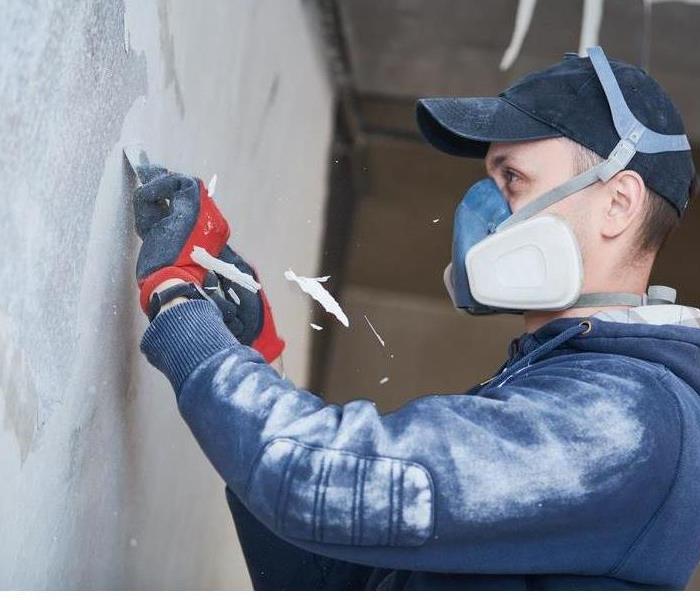 Soot needs to be professionally removed. Our team can help get rid of it - and its nasty odor!
Soot needs to be professionally removed. Our team can help get rid of it - and its nasty odor!
Fire damage can leave a trail of destruction in its wake. However, the byproducts that result from this damage need to be addressed as quickly as possible. They can have long-term side effects and wreck your belongings beyond repair. We’ll highlight the biggest nuisances that we can address after a fire damage event below:
Soot
Soot is one of the most notorious byproducts of fire damage. It leaves a black, sticky substance across your property’s structure and contents. Not only is this notoriously hard to clean, but it also leaves a foul-smelling odor behind. This odor can stick around even if the soot is completely cleaned from the surface! Our team completely eliminates soot and the nasty odor that comes with it.
Wet Smoke & Dry Smoke
There are two main types of smoke to worry about after a fire: wet smoke and dry smoke. Dry smoke isn’t much to worry about. While it leaves behind a powdery soot, it’s usually easy to clean off and doesn’t leave a ton of foul odors behind. Wet smoke, however, is harder to deal with. It’s caused by plastics burning, and the soot it leaves behind is rather sticky. It smears like regular soot and usually requires professional help to remove it.
Odor & Fire Restoration With SERVPRO
SERVPRO of East Boston, Chelsea, & Revere can eliminate fire damage and all of the byproducts that come with it. We can respond 24/7 - contact us to get help for your situation!
Fire Hazards To Keep On Watch During The Holidays
11/22/2024 (Permalink)
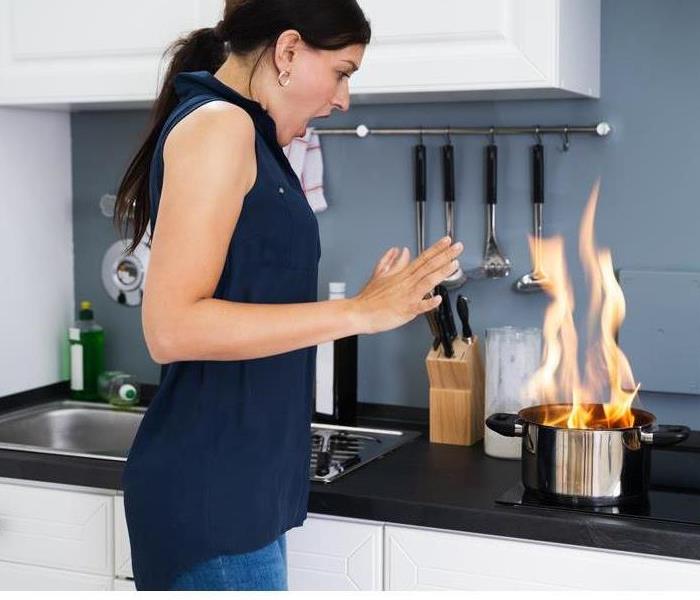 Don't let cooking fires linger for long! If they get out of control, you can always contact our team for help!
Don't let cooking fires linger for long! If they get out of control, you can always contact our team for help!
While the holidays can be a time of great joy and cheer, it’s also a time when people let their guard down. Fire accidents are very preventable around this time period! We’ll showcase the biggest hazards to watch out for below - and how to stop them!
Candle Fires
In general, you should never leave an open fire unattended, and this is especially the case with candle fires. Getting them knocked over could lead to a big fire that spreads rapidly!
Cooking Fires
When you’re cooking, you should be on high alert to what’s in front of you. Leaving your cooking unattended runs the risk of burning your food - and the immediate area around it! Cooking fires can be tough, especially where grease and gas are involved! The best way to prevent the spread is to keep watch.
Space Heaters
Space heaters are useful for fending off the winter cold, but when they’re placed too close to a flammable object, a fire can quickly break out. Before you turn on your space heater, check the area to ensure there are no fire hazards nearby. The more cautious you are, the better!
Fire Damage Restoration With SERVPRO
If your property experiences a fire accident, SERVPRO of East Boston, Chelsea, & Revere can hit the undo button! We’ll ensure that your property and its contents are completely restored, even eliminating soot odors left behind. Contact our team for 24/7 fire damage emergency assistance!
How to Prevent Kitchen Fires | SERVPRO of East Boston, Chelsea & Revere
6/16/2023 (Permalink)
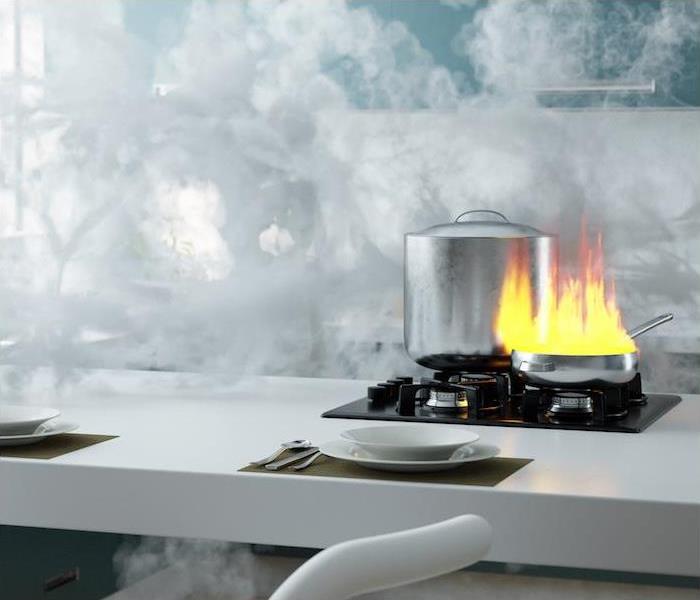 Fire disasters can happen at anytime. Call SERVPRO of East Boston, Chelsea, & Revere to get your home back in order once the smoke clears.
Fire disasters can happen at anytime. Call SERVPRO of East Boston, Chelsea, & Revere to get your home back in order once the smoke clears.
The kitchen is often considered the heart of a home, which means it requires special care! As disaster recovery professionals, we know how common and quick it can be for a small lapse in attention while cooking to spiral into a kitchen fire that requires professional fire damage repair and restoration services.
Here are a few top tips to stay safe in the kitchen:
1. Stay AttentiveIt can be tempting to walk away from the oven while it’s preheating, but never leave any of your appliances running unattended in the kitchen, including your stove, oven, or air fryer. Whether you’re frying, baking or broiling, you need to keep a close eye on your food. It just takes a second and a spark for the situation to get out of control.
2. Keep Flammable Objects AwayIt’s important to maintain a clear work zone in the kitchen that’s free of clutter. Common flammable objects, like oven mitts, paper products and kitchen towels, should be stored away from any heat sources. Keep an eye on your curtains, pot holders and plastic storage containers as well.
3. Check on Your AppliancesWhen it comes to kitchen fires, people first think of cooking accidents—but faulty electrical work is also a common source of fire incidents. To prevent an electrical fire, inspect your electrical appliances regularly for frayed cords or loose connections. Unplug anything that you’re not actively using and ensure items are cool to the touch before storing them in cabinets and drawers. Lastly, if you spot damage, don’t attempt to use the appliance. It’s time for a replacement!
4. Keep Safety Equipment on HandEvery kitchen should be equipped with essential safety gear, including fire extinguishers and a smoke detecter. Don’t forget to test your smoke detectors regularly to make sure they’re in proper working condition. It’s a wise idea to familiarize yourself with the proper usage of extinguishers and to place them in accessible locations throughout your property.
5. Avoid Grease BuildupGrease buildup can catch fire and spread quickly. Avoid starting a grease fire by regularly cleaning all kitchen surfaces, including stovetops, oven interiors and range hoods.
Even when you take every precaution, accidents happen! Luckily, the experienced technicians at SERVPRO of East Boston, Chelsea & Revere offer 24⁄7 emergency services so you’re never left wondering what to do next in the wake of a kitchen fire. Our fire damage repair and restoration services can help return your property to its original condition quickly and efficiently.
If you need reliable restoration services today, don’t hesitate to reach out. SERVPRO of East Boston, Chelsea & Revere is here to help, so contact us today!
Restoring Homes After Fire Damage: SERVPRO of East Boston, Chelsea, & Revere Is Here to Help
4/26/2023 (Permalink)
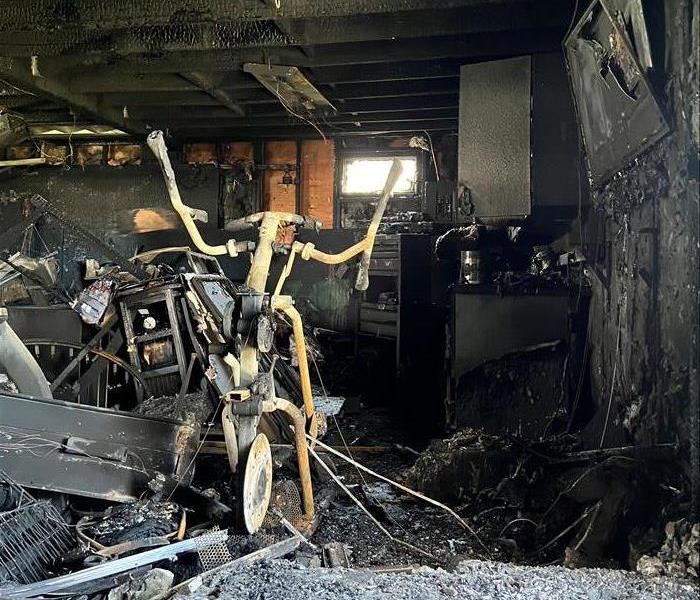 SERVPRO of East Boston, Chelsea & Revere is available 24/7 when fire damage restoration services are needed immediately. Call us now.
SERVPRO of East Boston, Chelsea & Revere is available 24/7 when fire damage restoration services are needed immediately. Call us now.
Fires can strike at any time and cause extensive damage to residential properties. The aftermath can be overwhelming and emotionally devastating for homeowners. That's why it's important to work with a trusted and experienced fire damage restoration company like SERVPRO of East Boston, Chelsea, & Revere in the Boston, MA area.
As part of the SERVPRO Team Luzzi network, they have the knowledge, expertise, and equipment to restore homes after fire damage. They start by assessing the extent of the damage and creating a customized plan for restoration. This may include cleaning and deodorizing, removing soot and debris, and repairing or replacing damaged materials.
SERVPRO of East Boston, Chelsea, & Revere also offers 24/7 emergency services to help homeowners deal with the immediate aftermath of a fire. They can board up and secure the property, and begin the restoration process as quickly as possible to prevent further damage.
In addition, they work with homeowners and their insurance companies to navigate the claims process, making the experience less stressful and more efficient.
Overall, if you're dealing with fire damage in a residential property in the Boston, MA area, SERVPRO of East Boston, Chelsea, & Revere is an excellent choice for restoration services. Their experience, expertise, and commitment to customer satisfaction make them a leader in the industry.
Fire Safety
4/1/2021 (Permalink)
It is that time of the year again, fires lots of fires.
Let us have a real talk about the power cords, extension cords, outlet plugs, and power strips. They are not the same thing and they are not meant to be plugged into each other. The only time a power strip can have an extension cord plugged into it is when it has been hard wired into the system.
Power strips/ surge protectors/ Hard wired power strips: They are different. But we use them for the same purpose added outlets and to extend the reach of our outlets to something further away. There are some precautions that many do not know or tend to ignore for convenience. Two different types of power are drawn from various equipment high power and low power. High power equipment tends to be stuff that turns one and off ovens, toasters, coffee pots, microwaves, space heaters, refrigerators etc. Low powered equipment tends to be more steady with its power use. Computers, cell phones, Radios, TV’s etc. Know what you are trying to plug in and make sure that you stay safe.
Extension cords: We all use them. Are we using them properly? Most likely NO. Did you know they are not meant for long term use. There is also a purpose to that pesky 3rd prong on the end. The one that many of you cut off. It is a grounding wire. Ok so you didn’t break it off on purpose. It got stepped on by accident and broke off. The fact that it is missing renders the cord no good. The equipment and items that are plugged into it are not grounded. (We will get into that later) If the extension cord is not being used do not leave it plugged in. It too can not handle high powered equipment.
3 prong vs 2 prong: OK this is a simple visual but has lasting consequences. So you have a wall plug that allows only 2 prong devices. You bought one of those 3 prong adapters, and it has that weird metal thing that you have no idea why it is there. So you plug it into the outlet plug in your device and carry on with your day. Guess what that’s wrong. That little metal piece has a purpose. You are supposed to plug the adapter in such a fashion that the metal piece hangs over the screw in the middle. You are supposed to remove the screw and secure this metal hook to the faceplate. That is what converts it to a grounded outlet. ( MIND BLOWN>>>WE KNOW)
Overloading: This is another step that many ignore. They think because they have space left on the power strip they can keep plugging things in. Or if they have something like Christmas lights they can connect an infinite number of strings together to get from one side to the other. You have to take into account the capacity load that the strip can take and how much energy each piece of equipment that is being plugged is going to draw. This will avoid over loading not only the strip or power cord but also the outlet. Many outlets are tied to others and do not run on an independent power source. Understanding how everything is connected can cut down on electrical issues.
Frayed cords ( NO duct tape is not a proper fix) Before you use any electrical cords, power cords, power strips, even the cords to the items you are trying to use. It is important to inspect them. Items that have been stored could have cracked or become frayed from age. They could have been gnawed at by an animal over the course of being stored. Place duct tape over the cord does not make it safe. Will it make the item work? Probably but it is NOT safe.
Grounding: So if you are not sure what grounding is or why it is important. It gives electrical surges a place to go other than into your home or office. Providing pathways for it to travel that are safe and less conductive. Easy enough. OK so your building or home is not properly grounded. What does that mean? It means all metal becomes a conductor. You along with the static in the air also becomes a conductor. In a power surge situation the energy will escape into the building. Your body can become the conductor as electrical currents flow through easily. Fires start more easily, electrical noises increases, as does the risk of electrical shock. The Electric Power Research Institute (EPRI) states that "better than 80% of all electronic system failures that are attributed to power anomalies are actually the result of electrical wiring or grounding errors or are generated by other loads within the customer's facility.
Being electrician is not for everyone. It is also not a part time hobby like a handy-man. Make sure that you are hiring a properly license and certified electrician. For those basics around the house have a light understanding of how all of your various options work. This will keep you and everyone in your home safe.
Fire at a local Boston restaurant
4/1/2021 (Permalink)
There was a kitchen fire at a local Irish pub in Boston. It was an electricial fire that caused fire damages to immediate areas and soot and smoke damage to the entire structure.
The crew arrived quickly and demo'd the area was severely affected by the fire. While there was a fire there was also water damage from the fire department extinguishing the fire. The crew has extract the water in the basement. The set up drying equipment for a three day dry out. Throughtout this process there was strong communication with the owners/ insurance company.
After day one, a full structural cleaning was performed to eliminate any evidence of any fire/water damage. Also, we cleaned all the contents, such as: glassware, bottles, tables, chairs, light fixtures, which you can imagine in a restaurant is a large job. This process is very tentious to ensure the cleaniness and the restaurant being restored to full function.
The restaurant was up in running within a week. Incuded in the was the rebuild team to repair damaged areas.
We know it's important to get back to business and our priority is meet their needs. Please entrust SERVPRO with all your restoration needs.
Smoke from fire can be dangerous.
9/18/2020 (Permalink)
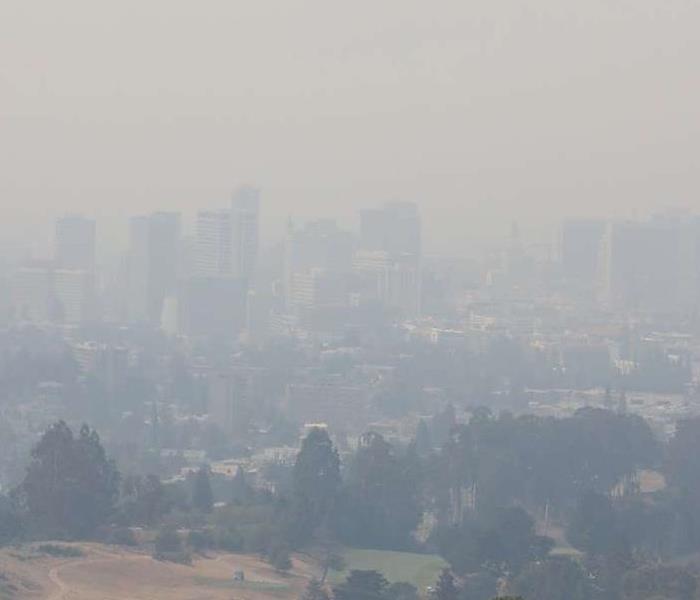 Smoke can make it hard to breathe, see, and even orient yourself. Get as low as you can and make your way to open spaces
Smoke can make it hard to breathe, see, and even orient yourself. Get as low as you can and make your way to open spaces
Here in New England we have been kept relatively safe from the perils of the extreme weather events that have pushed many areas of the world and this country to their limits.
As we continue to not get very little rain and more and more areas of the Northeast are showing up on the drought monitor. We could be subjected to these fires with one wrong spark.
It is important to know that when there is fire there is smoke. Smoke can contain a lot of deadly toxins and being prepared can make the world of difference. Since we all have access to masks these days it is important to keep one with you if you notice smoke in the air.
A lot of products burn when there is a fire, containing a wide array of chemicals beyond just wood. Keep this in mind if there is a fire in your area and you try and stay to defend your home. You can easily overcome with smoke long before the flames arrive. It is best to just get to safety.
We have enclosed some recommendations and guidelines from the CDC. Familiarize yourself with them and keep a spare one in all places you may go if you are every caught in the cross hairs of a fire.
Wildfire smoke can harm you in multiple ways. Smoke can hurt your eyes, irritate your respiratory system, and worsen chronic heart and lung diseases. This fact sheet tells you how you can protect your health and be safe if you are exposed to wildfire smoke.
What is Wildfire Smoke and Can it Make Me Sick?
Wildfire smoke is a mix of gases and fine particles from burning vegetation, building materials, and other materials. Wildfire smoke can make anyone sick. Even someone who is healthy can get sick if there is enough smoke in the air. Breathing in smoke can have immediate health effects, including:
- Coughing
- Trouble breathing normally
- Stinging eyes
- A scratchy throat
- Runny nose
- Irritated sinuses
- Wheezing and shortness of breath
- Chest pain
- Headaches
- An asthma attack
- Tiredness
- Fast heartbeat
Older adults, pregnant women, children, and people with preexisting respiratory and heart conditions may be more likely to get sick if they breathe in wildfire smoke.
Wildfire Smoke Can Affect High Risk Groups
Eight Tips for Protecting Yourself from Breathing Wildfire Smoke
If possible, limit your exposure to smoke. Here are eight tips to help you protect your health:
- Pay attention to local air quality reports and the US Air Quality Index External. When a wildfire occurs in your area, watch for news or health warnings about smoke. Pay attention to public health messages and take extra safety measures such as avoiding spending time outdoors.
- Pay attention to visibility guides if they are available. Although not every community measures the amount of particles in the air, some communities in the western United States have guidelines to help people estimate air quality based on how far they can see.
- If you are told to stay indoors, stay indoors and keep your indoor air as clean as possible. Keep windows and doors closed unless it is very hot outside. Run an air conditioner if you have one, but keep the fresh-air intake closed and the filter clean to prevent outdoor smoke from getting inside. Seek shelter elsewhere if you do not have an air conditioner and it is too warm to stay inside with the windows closed.
- Use an air filter. Use a freestanding indoor air filter with particle removal to help protect people with heart disease, asthma or other respiratory conditions and the elderly and children from the effects of wildfire smoke. Follow the manufacturer’s instructions on filter replacement and where to place the device.
- Do not add to indoor pollution. When smoke levels are high, do not use anything that burns, such as candles and fireplaces. Do not vacuum, because vacuuming stirs up particles already inside your home. Do not smoke tobacco or other products, because smoking puts even more pollution into the air.
- Follow your doctor’s advice about medicines and about your respiratory management plan if you have asthma or another lung disease or cardiovascular disease. Call your doctor if your symptoms worsen.
- Do not rely on dust masks for protection. Paper “comfort” or “dust” masks commonly found at hardware stores trap large particles, such as sawdust. These masks will not protect your lungs from smoke. An “N95” mask, properly worn, will offer some protection. If you decide to keep a mask on hand, see the Respirator Fact Sheet provided by CDC’s National Institute for Occupational Safety and Health.
- Avoid smoke exposure during outdoor recreation. Wildfires and prescribed burns—fires that are set on purpose to manage land—can create smoky conditions. Before you travel to a park or forest, check to see if any wildfires are happening or if any prescribed burns are planned.
https://www.cdc.gov/disasters/wildfires/smoke.html
Photo: Yalonda M. James / The Chronicle
Fireworks should be left to the professionals
6/30/2020 (Permalink)
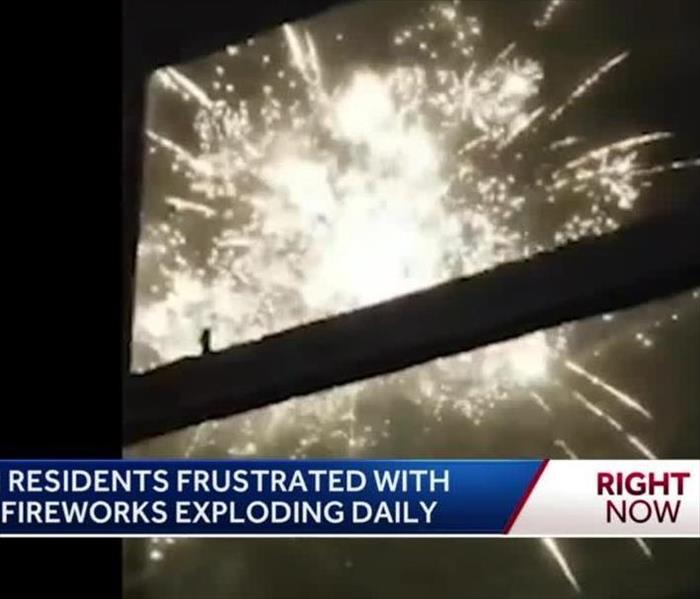 Firework complaints have gone up more than 500% in some communities. Let us all take a break from this year and find something else to do
Firework complaints have gone up more than 500% in some communities. Let us all take a break from this year and find something else to do
Fireworks have been all over the news as of late in Massachusetts. There are a number or reasons for the news stories. Some have been to notify us of cancelled town 4th of July events. Others have been to warn of their dangers due to buildings catching fire from a stray ember or rouge projectile. Yet one other news worth story is the fact the fireworks are illegal in this state for use by non-professional persons.
With so many of us home more and looking for things to do, many are turning to fireworks with NH being just such a short drive. We at SERVPRO of East Boston, Chelsea, Revere we urge you to refrain from using fireworks.
There are a lot of safety reasons to not use they. Personal safety is the key reason. One of our employees know someone who lost their hand to one a few years ago. Any firework injury could result in a hospital visit, which for an unavoidable issue during these novel times is not ideal.
Another reason to refrain from the use of fireworks is that many pets and people have PTSD and fear of the noise from it. Our friends family and especially our neighbors need our support more than ever. We may even see our neighbors more than we see our family these days. Trying to be mindful of everyone within the communities needs is more important than ever. The needs goes far beyond our desire for something to do here and there.
Our most cautionary reason for refraining from the fireworks is the damage to your home or someone else’s. Things are not what they normally are. Staying in a hotel while a home is fixed from the fire and water damage is not an easy decision or in many instances not an option. Having to leave your home or live in a partially ruined home for the sake of a firework is not an appealing thing to think about.
Below you will find an article from the National Safety Council that highlights some of the key points we have discussed more in depth. Let us all stay safe healthy and happy. This July 4th holiday.
https://www.nsc.org/home-safety/tools-resources/seasonal-safety/summer/fireworks
Summer is synonymous with barbecues, parades and fireworks. The National Safety Council advises everyone to enjoy fireworks at public displays conducted by professionals, and not to use any fireworks at home. They may be legal but they are not safe.
In 2017, eight people died and over 12,000 were injured badly enough to require medical treatment after fireworks-related incidents. Of these, 50% of the injuries were to children and young adults under age 20. Over two-thirds (67%) of injuries took place from June 16 to July 16. And while the majority of these incidents were due to amateurs attempting to use professional-grade, homemade or other illegal fireworks or explosives, an estimated 1,200 injuries were from less powerful devices like small firecrackers and sparklers.
Additionally, fireworks start an average of 18,500 fires each year, including 1,300 structure fires, 300 vehicle fires and nearly 17,000 other fires.
If You Choose to Use Legal Fireworks
If consumer fireworks are legal to buy where you live and you choose to use them, be sure to follow the following safety tips:
- Never allow young children to handle fireworks
- Older children should use them only under close adult supervision
- Never use fireworks while impaired by drugs or alcohol
- Anyone using fireworks or standing nearby should wear protective eyewear
- Never hold lighted fireworks in your hands
- Never light them indoors
- Only use them away from people, houses and flammable material
- Never point or throw fireworks at another person
- Only light one device at a time and maintain a safe distance after lighting
- Never ignite devices in a container
- Do not try to re-light or handle malfunctioning fireworks
- Soak both spent and unused fireworks in water for a few hours before discarding
- Keep a bucket of water nearby to fully extinguish fireworks that don't go off or in case of fire
- Never use illegal fireworksSparklers Are DangerousSparklers burn at about 2,000 degrees – hot enough to melt some metals. Sparklers can quickly ignite clothing, and children have received severe burns from dropping sparklers on their feet. According to the National Fire Protection Association, sparklers alone account for more than 25% of emergency room visits for fireworks injuries. For children under 5 years of age, sparklers accounted for nearly half of the total estimated injuries.
- Consider using safer alternatives, such as glow sticks, confetti poppers or colored streamers.
- Every year, young children can be found along parade routes and at festivals with sparklers in hand, but sparklers are a lot more dangerous than most people think.
- Better yet, grab a blanket and a patch of lawn, kick back and let the experts handle the fireworks show.
Photo Credit WCVB Channel 5
Hoarding and Fires do not mix
1/27/2020 (Permalink)
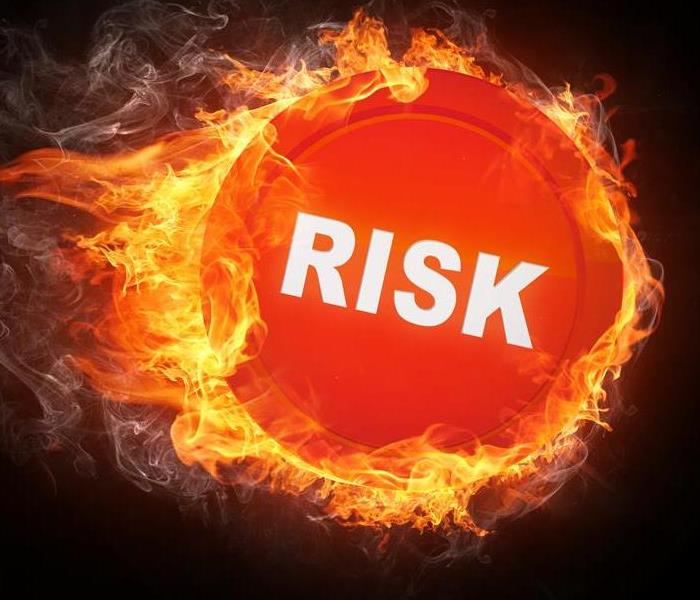 Risk of death and injury increase with a home that is a hoarding situation. Keep your home neat organized and under control.
Risk of death and injury increase with a home that is a hoarding situation. Keep your home neat organized and under control.
So you have a lot of stuff. It is your home you can do with it what you want right? Well technically yes, however that stuff can become a very dangerous and real hazard very quickly. Fire danger is a very real thing in any home exacerbated by excessive stuff can really posse a larger danger.
Fires on a normal day run through homes at a rapid rate. When your home is full of clutter and excessive stuff it can move that much faster. In as little as 30 seconds a fire can be well underway. Once you reach 1 minute the room can be full of thick black toxic smoke. The fire itself can reach temperatures of more than 600 degrees in no time. If this does not sound like an ideal environment for living things you would be right. These statistics are under normal living conditions things move a great deal faster when there is excess.
Many times, when you have things lining the walls you find that telling yourself it is stacked neatly so its not a hoard. This means you can be blocking an outlet, visibility to things plugged into those outlets mat be hindered. You may even have chemicals for cleaning lined up. Are they next to a heat source? Did you even think of that? Have you forgotten about one and the cap was off and spilled as you piled a bag of newspapers on top? As you add to the piles you can be pushing a plug into an outlet fraying the cord.
But it is neat and organized. If you cannot sweep a floor all the way over to the edges it is not neat and organized. If you have a hallway for example that has boxes running on each side and you have a pathway through the middle. While moving through this on a normal day you may something you can do with ease. If the home were to be full of smoke and you have to rely on feeling your way through that same hallway. As you reach for an edge the precariously stacked boxes may begin to tumble. You continue to reach, and they continue to fall. The smoke can hinder your breathing, you try to get lower to the ground because that was what you were taught. You are met with a pile of boxes that you cannot crawl through. Your path is now blocked.
Homes are set up for a reason with multiple entrance and exit routes. While on a daily basis you may not use them with frequency or maybe not at all. They still provide a valuable exit from a home. If you have decided the back door is not used so you will just pretend it is a corner, you can be in real trouble. Your main point of entry and exit could be blocked via the fire or items that have fallen. This could become a deadly decision in minutes.
In addition to the reduced entry and exit ways there is something to be said for the weight of the items that you keep within the home. While each floor has a specific load weight that it can hold. Once there is a fire involved these items will be doused with water adding significant weight to the floor load Often times this will cause a collapse that would not have normally happened. This adds to the danger, cost of the damages and can even prohibit rescue.
Large quantity of items add fuel to your current fire. It also creates a more difficult rescue attempt. It puts rescuers lives in danger, adds to the time it takes to reach you. If you are now trapped and having trouble getting out, they too are having trouble getting in. These blocked areas could be entry ways/ hallways/ stairwells. Your items could not only be blocking a pathway they could in fact be on fire.
Work on keeping hallways, and doorways free and clear of clutter and excessive furniture. Old mail, newspapers, magazines need to be discarded with the trash once they have been read or not needed anymore. Do not just put them in a bag or a box to save for later. The internet allows you to look up and reference most information saving you from needing a printed copy in your home.
Another key thing to helping reduce fire risk in your home is keeping electrical outlets free and clear of blockages. Do not pack items in front of them especially if you have things plugged into them. Not overloading an outlet and not using too many power strips or extension cords can also reduce potential for fires.
Please know that while we are living in a consumer driven time it is essential to keep your home in control. This will not only save you money, time and peace of mind. It just might save your life.
Fire risk with Aquarium
1/15/2020 (Permalink)
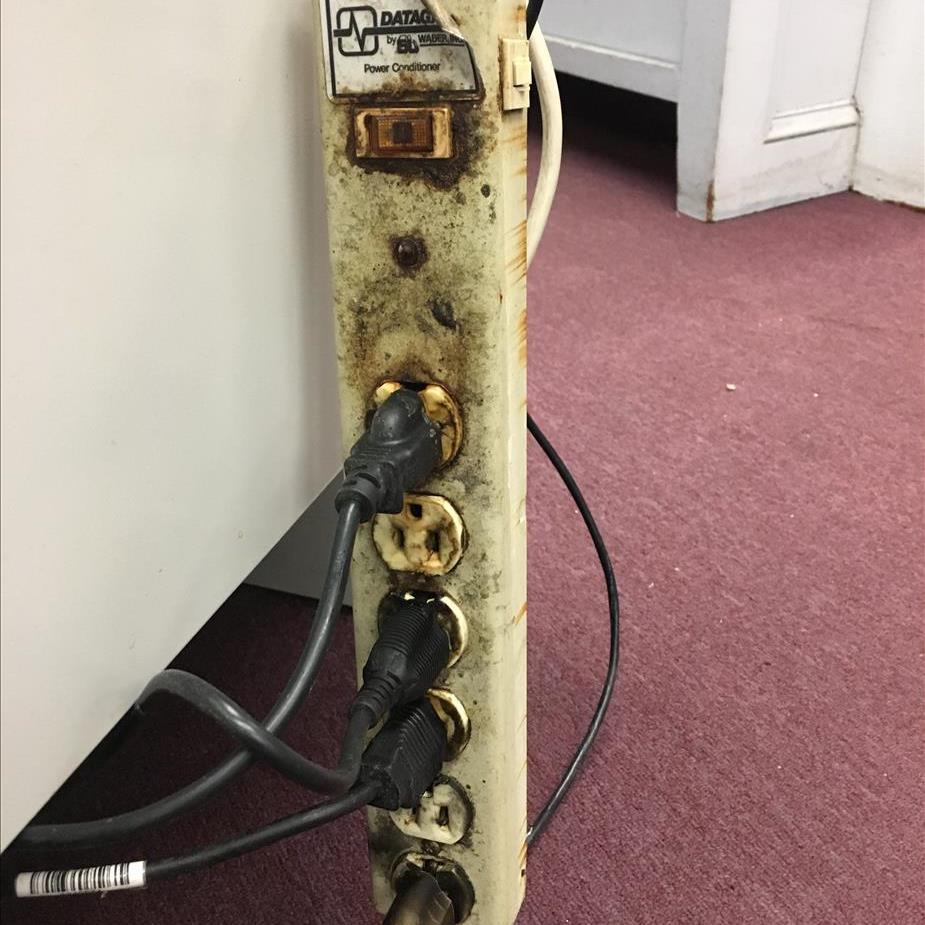 Power strip left sitting on the floor that then had a water damage problem
Power strip left sitting on the floor that then had a water damage problem
Fire damage with a home aquarium.
Aside from the obvious water damage they can cause. The old adage that water and electricity do not mix is there for a reason.
Well let us start with the basics of an aquarium and what sort of electrical power they really need. I mean they are tanks full of water what could they possibly need.
Lighting
Heating
Filtration
Pumps
So let us get started on the things to be careful about. A short circuit in a frayed or improperly placed wire can be detrimental to the overall safety of your home. This is an obvious one to most but what can come as a surprise is getting the improperly sized equipment for the volume of water that you have.
Some less obvious ones start at the very outlet your equipment will be plugged into. The law requires any outlet near water to be GFCI ( the ones with the test/ reset buttons in the middle) which is why you see them in bathrooms all the time. Most people do not have them outside of kitchen and bathroom areas and fail to consult with an electrician prior to setting up their aquarium.
While we are on the topic of outlets let us talk about how much electricity a standard outlet can handle because it is so easy to overload the outlet. A standard single outlet can hold approximately 2400 watts. Wattage can be tricky with equipment that needs to turn on and off. This creates a surge to the system that must be accounted for.
We see this most often with Christmas decorations during the holidays. Power strips and extension cords does not increase the number of things that can be safely plugged into it. It does give us a sense of false security especially if we got a fancy one with a lot of bells and whistles. Where we place these can play a roll in their safety. Make sure you never plug a power strip into an extension cord. Also avoid hiding the cord behind the aquarium for an out of site out of mind mentality can hide damage. You can not see if water is splashing over onto the tops of the cords, if somethings has fallen on top of them or if you have kinked up one of the cords causing it to break.
Heaters for example can have dire consequences. If the motor burns out can be an obvious danger, if he heater is too small and needs to run constantly to try and keep the water at the desired temperature. Should your system require multiple heaters you must ensure they are always fully submerged . Water changes and or drops to the water level must be met with heaters being turned off at least 20 minutes prior to the adjustment. This allows the mechanism time to cool down and avoid a short to the unit.
Lighting is often very close to the water and may not have the proper protection from splash back or spill overs creating shorts in the ballasts. These shorts can result in sparks flying over to a curtain or wall. They can also burn out the lighting unit itself and cause a fire. Lighting is also not meant to be in the water unlike the heater. This means extra care must be taken to keep the cords out of the way.
Filtration systems for many aquariums are set up in a separate room. That being said it is imperative that these systems be on all the time for the health and safety of the plants and animals. While daily monitoring for these is not necessary it is a good habit to get into daily equipment checks. A failure or blockage of a filter can result in an overload on the system that will try and keep running it. Burning out the motor. This motor burn out can simply stop working or it can start a fire in an unmonitored section of your home going unnoticed longer than normal.
Pumps water pumps are another thing that need to run constantly and since water pumps through them failure and overloading is imminent. It is not a matter of if it is a matter of when. This means you have to check this equipment often and you have to ensure you have the proper size pump for adequate water movement. It is also essential for you to have it plugged into an outlet that can handle the power.
Misuse of power strips and extension cords cause more than 3000 home fires every year, resulting in 4000 trips to the emergency room killing over 50 people. Now while all of these are not from aquariums this is still a staggering number. Electricity is not a hobby and we always suggest consulting experts for every aspect of your projects that involve electricity. This article is meant to be informative and get you to understand the damage that could occur. This is not meant to be advise or guidance on any aquarium work that you undertake.
Extension cords, power strips and more...
12/18/2018 (Permalink)
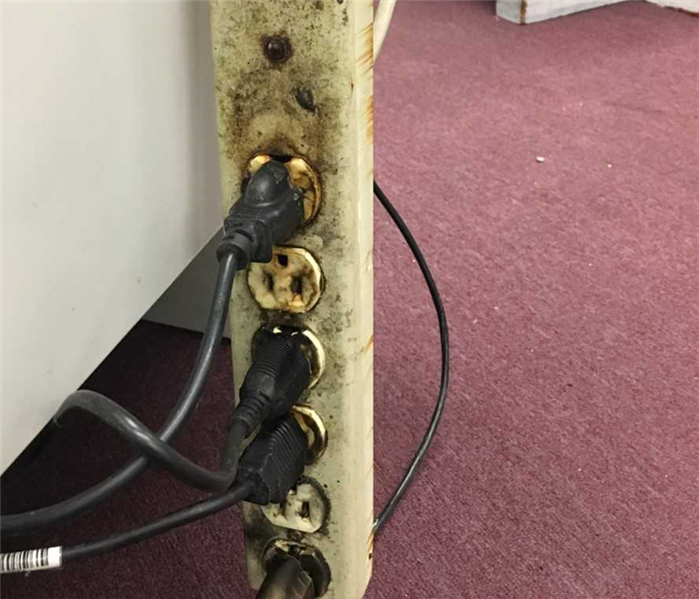 There are so many things wrong with this picture. 1) it was on the floor thus got wet. 2) Note that on the bottom is another extension cord plugged in
There are so many things wrong with this picture. 1) it was on the floor thus got wet. 2) Note that on the bottom is another extension cord plugged in
It is that time of the year again, fires lots of fires.
Let us have a real talk about the power cords, extension cords, outlet plugs, and power strips. They are not the same thing and they are not meant to be plugged into each other. The only time a power strip can have an extension cord plugged into it is when it has been hard wired into the system.
Power strips/ surge protectors/ Hard wired power strips: They are different. But we use them for the same purpose added outlets and to extend the reach of our outlets to something further away. There are some precautions that many do not know or tend to ignore for convenience. Two different types of power are drawn from various equipment high power and low power. High power equipment tends to be stuff that turns one and off ovens, toasters, coffee pots, microwaves, space heaters, refrigerators etc. Low powered equipment tends to be more steady with its power use. Computers, cell phones, Radios, TV’s etc. Know what you are trying to plug in and make sure that you stay safe.
Extension cords: We all use them. Are we using them properly? Most likely NO. Did you know they are not meant for long term use. There is also a purpose to that pesky 3rd prong on the end. The one that many of you cut off. It is a grounding wire. Ok so you didn’t break it off on purpose. It got stepped on by accident and broke off. The fact that it is missing renders the cord no good. The equipment and items that are plugged into it are not grounded. (We will get into that later) If the extension cord is not being used do not leave it plugged in. It too can not handle high powered equipment.
3 prong vs 2 prong: OK this is a simple visual but has lasting consequences. So you have a wall plug that allows only 2 prong devices. You bought one of those 3 prong adapters, and it has that weird metal thing that you have no idea why it is there. So you plug it into the outlet plug in your device and carry on with your day. Guess what that’s wrong. That little metal piece has a purpose. You are supposed to plug the adapter in such a fashion that the metal piece hangs over the screw in the middle. You are supposed to remove the screw and secure this metal hook to the faceplate. That is what converts it to a grounded outlet. ( MIND BLOWN>>>WE KNOW)
Overloading: This is another step that many ignore. They think because they have space left on the power strip they can keep plugging things in. Or if they have something like Christmas lights they can connect an infinite number of strings together to get from one side to the other. You have to take into account the capacity load that the strip can take and how much energy each piece of equipment that is being plugged is going to draw. This will avoid over loading not only the strip or power cord but also the outlet. Many outlets are tied to others and do not run on an independent power source. Understanding how everything is connected can cut down on electrical issues.
Frayed cords ( NO duct tape is not a proper fix) Before you use any electrical cords, power cords, power strips, even the cords to the items you are trying to use. It is important to inspect them. Items that have been stored could have cracked or become frayed from age. They could have been gnawed at by an animal over the course of being stored. Place duct tape over the cord does not make it safe. Will it make the item work? Probably but it is NOT safe.
Grounding: So if you are not sure what grounding is or why it is important. It gives electrical surges a place to go other than into your home or office. Providing pathways for it to travel that are safe and less conductive. Easy enough. OK so your building or home is not properly grounded. What does that mean? It means all metal becomes a conductor. You along with the static in the air also becomes a conductor. In a power surge situation the energy will escape into the building. Your body can become the conductor as electrical currents flow through easily. Fires start more easily, electrical noises increases, as does the risk of electrical shock. The Electric Power Research Institute (EPRI) states that "better than 80% of all electronic system failures that are attributed to power anomalies are actually the result of electrical wiring or grounding errors or are generated by other loads within the customer's facility.
Being electrician is not for everyone. It is also not a part time hobby like a handy-man. Make sure that you are hiring a properly license and certified electrician. For those basics around the house have a light understanding of how all of your various options work. This will keep you and everyone in your home safe.
Space Heater Safety
11/23/2018 (Permalink)
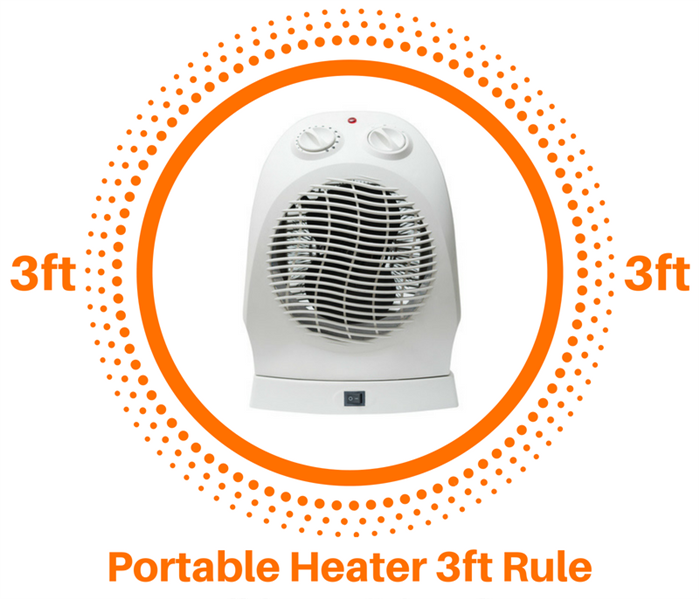 Space heaters are a great way to add warmth to a room. Being safe and understanding the best way to do that is essential.
Space heaters are a great way to add warmth to a room. Being safe and understanding the best way to do that is essential.
It may not be officially winter in New England but it is sure has not stopped mother nature from delivering us some snow and arctic blasts. With century breaking cold coming for Thanksgiving this year we really need to look at home heating. Many in Massachusetts are not even in their homes due to fires in the Merrimack Valley area. That means more people will be using space heaters to stay warm. They are small, portable and cost effective. That alone does not make them safe.
Space heaters and other heating equipment causes almost 70,000 fires every year. Damages both monetarily, physically and emotionally are insurmountable and sadly as is the case in California can often times spread having devastating results. Winter is a dry season with a lot of leaves on the ground. That being said let us focus on how to stay safe while we all try to stay warm.
Heating equipment is the second leading cause of home fires in the United States. More than 65,000 home fires are attributed to heating equipment each year. These fire result in hundreds of deaths, thousands of injuries and millions of dollars in property damage.
When you get a space heater making sure that the new one is the right fit for you needs will help with keeping everyone safe. Space heaters use electricity which means these is a risk of sparks, frayed or faulty wiring. Below you will find some key point to use as consideration when using them.
Choosing the right heater for your space can go a long ways in terms of keeping you safe. There is a little bit of math involved but it is relatively easy. Get the square footage of the room, it takes approximately 10 watts per square foot. So a 12X12 SQ Ft room needs about 1,440 watts to heat. Ok but the packaging for the heaters say BTU’s so now what. Multiply the watts by 3.41. A single watt is equivalent to 3.41 watts. So that sized room needs about 4,910 BTU unit heater. Guess what unless your room is much bigger than that most heaters run in at 5,100 BTU’s or 1500 watts. Pretty convenient right. Yes we thought so to. Just like a lot of products out there are counterfeit or knock offs. It is important to avoid these as they will have not been safety tested properly.
So now you have the proper sized space heater. Let us take a look at where the best place is to put it, along with what are some basic safety tips.
Make sure your space heater has the label showing that it is listed by a recognized testing laboratory.
- Make sure you are familiar with how your specific unit works. Read all the warnings and labels. The instructions can vary from unit to unit so do not assume the one you had years ago functions the same. Technology and requirements change. .
- Before use it is important to inspect the unit for broken cords, frayed wires, any damage or cracks. If any of that is found DO NOT USE
- Never leave a space heater unattended. Turn it off when you're leaving a room or going to sleep, and don't let pets or children play too close to a space heater.
- DO NOT use these units to try and cook food, dry anything or warm up a bed. Space heaters are only meant to provide heat to a space only. Woman in Lowell caused a fire 2 day after she was given a space heater for misusing it.
- Change all batteries in every smoke alarm in the house before using a space heater. There needs to be one on every floor. Make sure you conduct monthly tests to ensure proper working order.
- Keep them at least 3 ft away from anything flammable. This includes rugs, curtains, blankets and paper products.
- Keep cords and placement location out of main high traffic areas of your home. If you have to run the cord through an area that is walked through a lot tape the cord down. As flush against a wall as possible.
- They go directly into WALL outlets. DO NOT ***DO NOT*** use an extension cord or power strip. It is also important to not plug other high energy draining devices into the outlet. Sudden surges such as a toaster oven can cause overheating and start fires.
- The best places for a space heater is on the floor. For a few reasons. One of which is that heat rises and you want as much warm air to move throughout the room. The other is that it is a flat surface. If placed on a table or piece of furniture you run the risk of something else being placed on or near it increasing the risk of fire.
- If you are not using the space heater, make sure it is always unplugged.
Ok so now that you know how to stay safe and properly use a space heater lets get to enjoying the warmth. Have a safe and happy holiday season.
Holidays and Fire safety
11/12/2018 (Permalink)
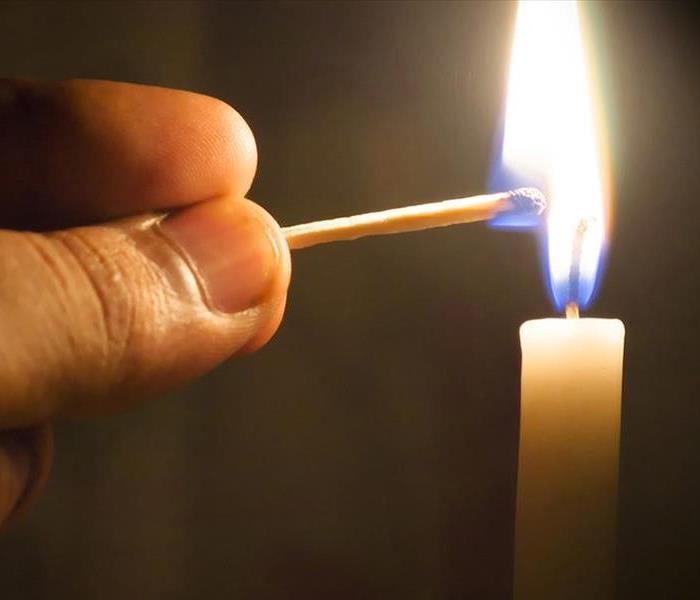 Fire risk in homes increases during the holiday season. Candles, cooking, fireplaces and dried trees all add to the risk. Prepare, plan, prevent.
Fire risk in homes increases during the holiday season. Candles, cooking, fireplaces and dried trees all add to the risk. Prepare, plan, prevent.
Fire safety…
With the recent infernos spreading throughout California we feel the need to remind people about fire dangers here at home. The holidays are fast approaching being able to spend time with the ones that we love. Often that time is spent in the kitchen, next to a roaring fire, creating a mood with some extra candles, curled up in an electric blanket , or even just getting out the chill with a boost of heat from a space heater. With temperatures dipping there is also an increased instance of smoking within in the home as it is simply too cold for some to go outside.
Many of these things are traditions that shape our lives. Yet these are the same traditions that see a spike in disaster this time of the year. We will dissect each of these to ensure you have the tips you need to keep you and the traditions alive.
Smoking inside, this is actually the easiest one to avoid. JUST DO NOT DO IT… The number one cause of deaths from fires every year is this one thing. Many times it is out of exhaustion or combined with something else such as alcohol. Falling asleep with a lit cigarette or other similar device has devastating consequences. So how do you stay safe with this one..
- Stay outside
- Use a deep ashtray ( not the ground is not safe to toss it)
- Fill the ashtray with a sand water combination & keep it far away from anything that can burn
- Stay away from flammable materials such as oxygen and gasoline ( Yup that’s right no smoking in the garage either)
- Use fire safe cigarettes (Yes they exist)
- E-Cigarettes count too…they can explode.. ignite while charging or even in transport be wary and use the same precautions
Electrical Fires
These fires are caused by a number of different things. Over the holiday season many of us have more lights plugged in to illuminate our lives during season. Extra lights, extension cords, power strips and additional strain on many of the outlets within your home. Before you get started any additional cords need to be checked for frayed wires, cracked, chipped, or chewed( animals like to do that) . Do not overload any one outlet, if you are not sure which outlet coincides with what have a certified electrician check it out for you. Do not run a cord in main walking paths they can pose a tripping hazard but could also be partially pulled out. This could cause serious fire risk from an improper connection. Never use an outlet that does not have the faceplate properly installed. Below is a more entailed punchlist.
- Ensure bulbs match the wattage output of the device
- Do not REPETE DO NOT plug a power strip into another power strip.
- Do not overload an outlet
- Avoid tripping the breaker if you do you have overloaded the outlet.
- Check for frayed, chipped, cracked or chewed wires.
- Place all power strips up off of the floor. ( This keeps it out of reach of kids and pets and water should you have a pipe break.
- Use only 1 heat producing items per outlet. (i.e coffee pot, space heater, toaster etc.
Candles
Candles so many people add candles for both religious and aesthetical reasons over the holiday season. The top 3 days for candle fires are Christmas, New Years Eve and New Years day. Falling asleep with a lit candle is a key factor to these fires. Almost 60% were caused because a combustible material was left too close to the lit candle itself. So what do you do to have them safely in your home.
- Blow them out when you leave the room for an extended period of time.
- Keep them 1ft at a minimum away in all directions from flammable materials.
- Use a steady surface
- Use a candle holder with a wide base.
- Do not place in a window
- Keep all matches, ignition materials or combustible materials out of reach of children.
- If someone in the home uses oxygen DO NOT use them no matter the reason.
Heating fires.
These are the peak months for heating fires. December, January, February. Many of the electrical and smoking safety tips apply here. Increasing the usage of fireplaces & space heaters. It is essential for all outlets to not be overloaded. Ensure that only one heat producing appliance or large use appliance is plugged into the outlet. Do not under any circumstances use a power strip, or extension cord for these devices.
- Provide proper fire safety glass. ( regular glass will explode)
- Add any necessary screening metal / glass combinations
- Fireplace extensions that are non-flammable to catch any escaping embers or ashes
- Never transfer hot ashes
- No frayed wires
- Keep all heat sources 3ft away from any flammable
Cooking:
Last but certainly not least. Cooking is a significant cause of fires in this country. Most home fires actually stem from cooking. Be it deep frying a turkey ( BAD IDEA), Grease fires, oven or stove top cooking . Cooking is fun, engaging and full of memories made. Make them happy ones. Develop good habits.
- Never leave a flame unattended.
- Keep flammable materials away from the stove. ( towels, oven mitts, wooden utensils etc.)
- Keep decorations away from stoves as well
- Always set incremental timers to periodically check on items in oven 15 min is a good recommendation.
- Use splatter shields.
- Have a portable fire extinguisher with the proper fire rating code on hand.
- Fighting the fire yourself can result in serious injuries. Best to get out and call a professional.
Nothing is guaranteed. Accidents do happen and the best things we can do is be prepared and cautious. It is important to know that if a fire breaks out knowing as soon as possible can and will save your life. Changing the batteries in your smoke and carbon monoxide detectors every 6 months is the best way to get make sure you are notified right away. You can have a little as 2 minutes to get out of the house once a fire takes hold in a home. Check your cords on everything replace or adjust accordingly, have safe distance from any flammable materials, be diligent about the kids, and pets around kids electricity and flames.
While nothing is 100% guaranteed taking steps to protect yourself, your loved ones as well as neighbors can go a long way. Develop good habits that allow all memories to be ones that we can share and cherish.
Fire Fire everywhere … What do you do ...
7/30/2018 (Permalink)
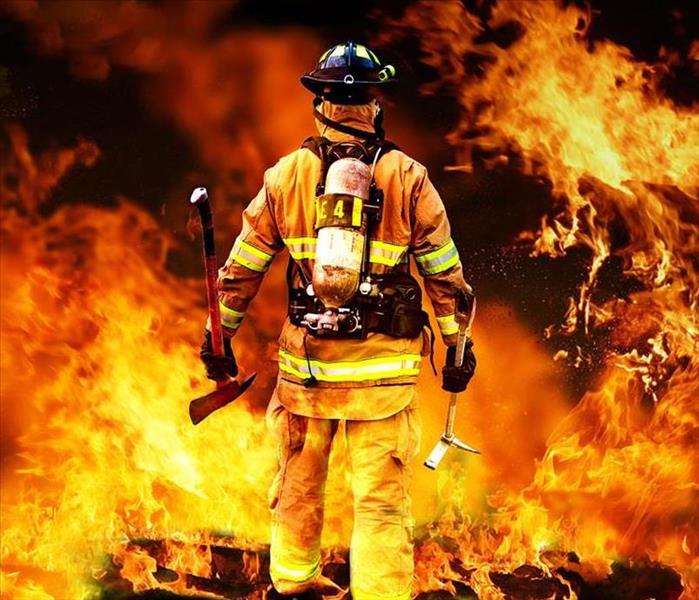 These men and women put their lives on the line daily for us. Please take steps, be cautious, and mindful so they do not have to.
These men and women put their lives on the line daily for us. Please take steps, be cautious, and mindful so they do not have to.
Our friends at NFPA have some great tips and ideas on how to prevent fires. Due to the fires out west that are leveling homes and killing both firefighters and those who live in that area.
These fires are fast moving and the amount of smoke they cause can be just as deadly as the flames. Please use caution when presented with a fire situation. Even better is to use caution to prevent them.
Today, people who die in fires typically die in ones and twos, in their own homes and vehicles.
Fire in the home
Home is the place people feel safest from fire, but it’s actually the place they’re at greatest risk. Approximately 80% of all U.S. fire deaths occur in the home; an average of seven people die in home fires every day.
According to NFPA’s latest reports, home fires and home fire deaths declined by about 50% since 1980. However, the 7.8 deaths per 1,000 reported home fires reflects a 10% increase over the 7.1 rate in 1980. In other words, while the number of U.S. home fires and home fire deaths has significantly declined over the past few decades, the death rate per 1,000 reported fires is actually a little higher. These numbers show that while we’ve made strong progress in preventing fires, mitigating their effects when they do happen remains a challenge.
Today’s homes burn faster than ever. Experts say you may have a little as two minutes (or even less) to safely escape a typical home fire from the time the smoke alarm sounds. Modern home furnishings, along with the fact that newer homes tend to be built with more open spaces and unprotected lightweight wood construction, all contribute to the increased rate at which home fires burn.
The death toll of home fires can be reduced through:
- Cooking. Cooking is by far the leading cause of home fires and injuries in the U.S. each year, and is the second-leading cause of home fire deaths. Unattended cooking represents the leading cause of these fire. People get distracted by children, pets or visitors, sometimes forgetting that they left food cooking. There is no safe period of time to leave cooking unattended. Almost two-thirds of home cooking fires involve the range, especially the cooktop. A 1999 CPSC study found that about two-thirds of home range fires started within the first 15 minutes of cooking; this increased to 83% for frying fires.
- Heating equipment. Heating equipment is the second leading cause of home fires, and third leading cause of home fire deaths. Most heating-related fire deaths can be traced to space heaters—a category that includes fixed and portable space heaters, including wood stoves. Space heaters (excluding fireplaces and chimney) most often caused fires when something that could catch fire was left too close. Most fireplace and chimney fires were caused by creosote buildup. These can be prevented by regular cleaning.
- Electrical. Flipping a light switch. Plugging in a coffeemaker. Charging a laptop computer. Electricity is such a ubiquitous part of our daily lives that it’s easy to overlook its power and potential for fire-related hazards. In fact, electrical distribution and lighting equipment represents the third-leading cause of fires. Wiring and related equipment was involved in 70 percent of these incidents; cords or plugs were involved in only 10 percent of the electrical distribution or lighting fires, but these fires caused more than one-quarter (28 percent) of the associated deaths.
- Smoking materials. Lighted tobacco products — almost always cigarettes — are the leading cause of fatal fires in the home, causing an average of 560 deaths per year. Typically, abandoned or discarded smoking materials ignite trash, mattresses and bedding, or upholstered furniture, with the majority of fatal smoking-related fires starting in the bedroom, living room, family room or den.
- Wildfires. While wildfires have traditionally been considered a concern only in the western half of the U.S., hotter temperatures, severe drought and a growing number of people living in the wildland-urban interface have played a role in increasing the risk in states all across the country. And with some of the hottest summers and winters on record in recent years, wildfires are burning larger than ever before and destroying twice as much land area each year as they did 40 years ago, and the threat continues to increase.Most fire deaths are not caused by burns, but by smoke inhalation. Often smoke incapacitates so quickly that people are overcome and can’t make it to an otherwise accessible exit. The synthetic materials commonplace in today’s homes produce especially dangerous substances. As a fire grows inside a building, it will often consume most of the available oxygen, slowing the burning process. This “incomplete combustion” results in toxic gases.particles: Unburned, partially burned, and completely burned substances can be so small they penetrate the respiratory system’s protective filters, and lodge in the lungs. Some are actively toxic; others are irritating to the eyes and digestive system.toxic gases: The most common, carbon monoxide (CO), can be deadly, even in small quantities, as it replaced oxygen in the bloodstream. Hydrogen cyanide results from the burning of plastics, such as PVC pipe, and interferes with cellular respiration. Phosgene is formed when household products, such as vinyl materials, are burned. At low levels, phosgene can cause itchy eyes and a sore throat; at higher levels it can cause pulmonary edema and death.
- In addition to producing smoke, fire can incapacitate or kill by reducing oxygen levels, either by consuming the oxygen, or by displacing it with other gases. Heat is also a respiratory hazard, as superheated gases burn the respiratory tract. When the air is hot enough, one breath can kill.
- vapors: Foglike droplets of liquid can poison if inhaled or absorbed through the skin.
- Smoke is made of components that can each be lethal in its own way:
- The killing fumes
When oxygen levels are at...
...a person experiences:
21 percent
Normal outside air
17 percent
Impaired judgment and coordination
12 percent
Headache, dizziness, nausea, fatigue
9 percent
Unconsciousness
6 percent
Respiratory arrest, cardiac arrest, death
https://www.nfpa.org/News-and-Research/News-and-media/Press-Room/Reporters-Guide-to-Fire-and-NFPA/Consequences-of-fire
Space Heaters and Smoking Material Fire Safety..
11/27/2017 (Permalink)
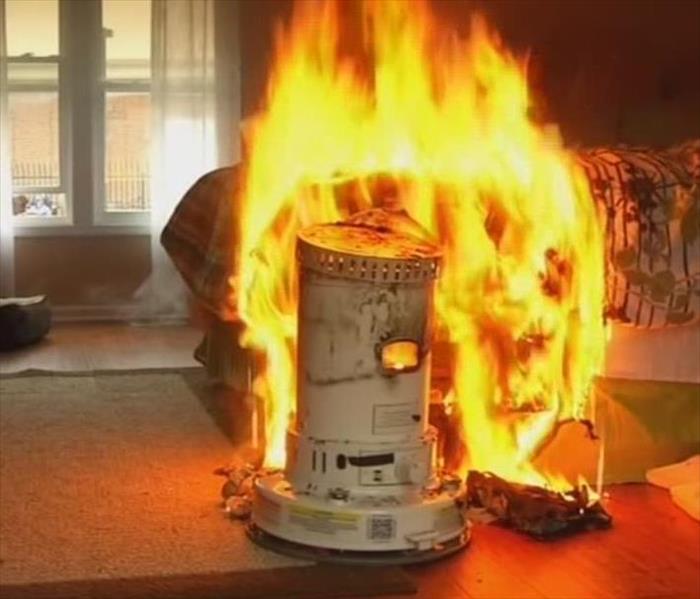 Space heaters even infrared ones need to be attended to. Just like Smoking materials .. Please stay alert to remain safe...
Space heaters even infrared ones need to be attended to. Just like Smoking materials .. Please stay alert to remain safe...
With the first few major fires of the season having tragic results in and around Boston, we feel the need to write this article.
Two of the deadly fires were a result of improperly disposed of smoking materials while the other was a space heater. We have written article in depth about these topics but really need to reiterate the fact that these are quick moving and fast spreading. Many of which occur at night while these materials are unattended.
Let us start with the smoking materials.
This is the number one cause of death in home fires.
Many industries have made efforts to aid in the reduction of death and injury from these kinds of fires. The mattress and furniture industry have been required to use flame resistant materials in manufacturing. New fire safe cigarettes have been developed and are required to aid in reduction of fires starting in the first place. These measures cannot and should not replace the smokers properly disposing of lit or smoldering products. We need to change our mindset and not rely on companies to make things safer for our friends and families.
We all know the dangers that smoking has on our overall health yet many still continue to smoke. All too often while driving down the road someone will toss a lit cigarette they are done without the window. While seemingly innocent when it comes in contact with the dry under brush and fallen leaves this can spark a major problems for so many. This is not an ideal way to dispose of a lit object period.
With the holiday season upon us many of us will partake in joyous occasions which often includes alcohol. While we support good time these drinks do impede judgment, make you sleepy, and reduce awareness. Coupled with many do smoke socially this can be a recipe for a disaster. When you have a smoke right before bed, but you are tired all too often many will fall asleep with the cigarette in their hand or even more scary in their mouth. The images of someone sleeping with a cigarette hanging out of their mouth is often a funny thing yet is a very dangerous event. As they sleep and muscles relax those funny images become deadly. Cigarettes falling out of the mouth or hand unknowingly onto the floor. Allowed to go unchecked, smoldering on a dry article of clothing, carpet or bed can quickly get out of hand. Deaths in these types of fires are often NOT the individual that was smoking the cigarette.
Please stay aware and if you see something say or do something you may just save a life. Properly dispose of the smoking materials even if they are not yours.
Here are some tips from our friends at National Fire Protection Association
- If you smoke, smoke outside.
- Whenever you smoke, use deep, wide, sturdy ashtrays. Ashtrays should be set on something sturdy and hard to ignite, like an end table.
- Before you throw out butts and ashes, make sure they are out. Dowsing in water or sand is the best way to do that.
- Check under furniture cushions and in other places people smoke for cigarette butts that may have fallen out of sight.
- Smoking should not be allowed in a home where medical oxygen is used. ( Someone in Maine just had a home explosion due to this) .. Oxygen is flammable ….Very FLAMMABLE… Be smart and safe…. Others will be affected.
- To prevent a deadly cigarette fire, you have to be alert. You won’t be if you are sleepy, have been drinking, or have taken medicine or other drugs. These are the second leading cause of home fires and injuries and the third cause of death. As Temperatures dip and the cold settles into the homes we all seek to stay warm, many of us turn to space heaters. While this is a great way to provide an infusion of concentrated heat into the areas of the home we are in or live in they can be very dangerous if not used properly.
- The second is the space heater.
- Keep them at least 3ft away from any and all flammable materials.
- This includes curtains, furniture, rugs, bedding, paper, Christmas trees, and holiday decorations.
- Turn them off when you are not home or cannot monitor properly i.e. when you are sleeping. Warm up the room and get an extra blanket to hold in the heat but turn that heater off when you go to sleep
- When buying a heater, look for one that has been tested and labeled by a nationally recognized testing company, such as Underwriter’s Laboratories Inc. (UL).
- Place the heater on a level surface away from areas where someone might bump into it and knock it over.
- Avoid using extension cords. If you must use an extension cord, make sure it is a heavy duty cord marked with a power rating at least as high as that on the label of the heater itself.
- Supervise children and pets when a space heater is in use.
- Keep electric heaters away from water. Never use them near a sink or in the bathroom.
- The sale and use of unvented kerosene heaters is illegal in Massachusetts.
- We hope this will make you think about these two causes of fires and use even just one tip to save a life maybe even your own. Share this tip with anyone you know that smokes or uses space heaters. Have a safe and happy holiday season with your friends and family. Let us work together to create lasting memories we can all be happy about. Not the memories that bring sadness over the holiday season. Being with our loved ones is precious and every moment we can add to it should be treasured. DO NOT cut those memories short because of a careless mistake. Check back with us often for this and other important safety tips and tricks.
Holiday Fire Statistics
11/1/2017 (Permalink)
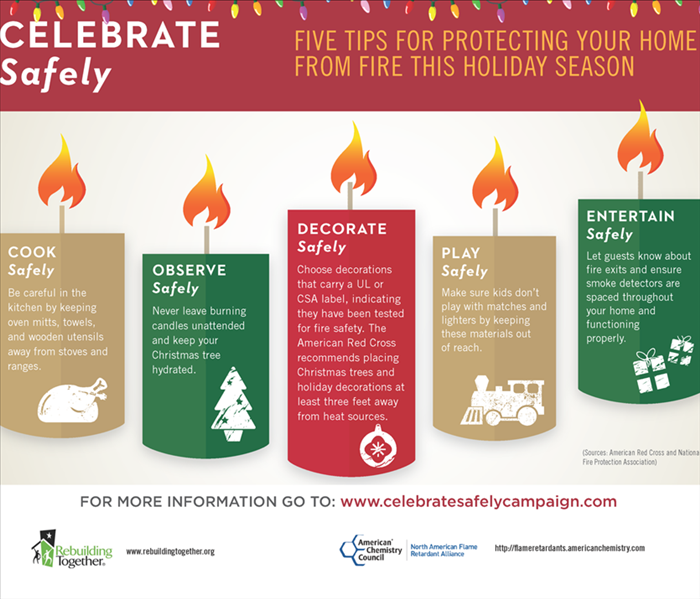 Having the holiday season fast approaching the need to remind everyone of home fire safety.. Please make this holiday season SAFE AND FUN..
Having the holiday season fast approaching the need to remind everyone of home fire safety.. Please make this holiday season SAFE AND FUN..
Home Fire statistics are an important way to stay safe this holiday season. Knowing where most problems stem from can lead to more attention being paid to those areas or activities .We have borrowed this information from NFPA ( National Fire Protection Association). Hoping to keep you safe and secure this Holiday season
Christmas trees
- Between 2010-2014, U.S. fire departments responded to an average of 210 home fires that started with Christmas trees per year. These fires caused an average of 6 deaths, 16 injuries, and $16.2 million in direct property damage annually.
- On average, one of every 34 reported home fires that began with a Christmas tree resulted in a death, compared to an average of one death per 142 total reported home fires.
- Some type of electrical distribution or lighting equipment was involved in one-third (35%) of home Christmas tree fires.
- Twenty-three percent of Christmas tree fires were intentional.
- Two of every five (38%) home Christmas tree fires started in the living room, family room, or den.Holiday decorations
- A live Christmas tree burn conducted by the U.S. Consumer Product Safety Commission (CPSC) shows just how quickly a dried out Christmas tree fire burns, with flashover occurring in less than one minute, as compared to a well-watered tree, which burns at a much slower rate.
- U.S. fire departments responded to an estimated average of 860 home structure fires per year that began with decorations, excluding Christmas trees, in 2009-2013. These fires caused an annual average of one civilian fire death, 41 civilian fire injuries and $13.4 million in direct property damage.
- Ten percent of decoration fires were intentional.
- The decoration was too close to a heat source such as a candle or equipment in nearly half (45%) of the fires.
- One-fifth (20%) of the decoration fires started in the kitchen. One out of six (17%) started in the living room, family room or den.
- One-fifth (20%) of the home decoration fires occurred in December.
- Candles
- Candles started 38% of home decoration structure fires.
- Half (51%) of the December home decoration fires were started by candles, compared to one-third (35%) in January to November.
- The top three days for home candle fires were Christmas, New Year’s Day, and Christmas Eve.Holiday cooking
- Source: NFPA's "Home Structure Fires Involving Decorations" report
- Thanksgiving is the peak day for home cooking fires, followed by Christmas Day and Christmas Eve.
- Cooking equipment was involved in 18% of home decoration fires. This can happen when a decoration is left on or too close to a stove or other cooking equipment.Fireworks
- Source: NFPA's "Home Fires Involving Cooking Equipment" report
Holiday season is fast approaching..
10/19/2017 (Permalink)
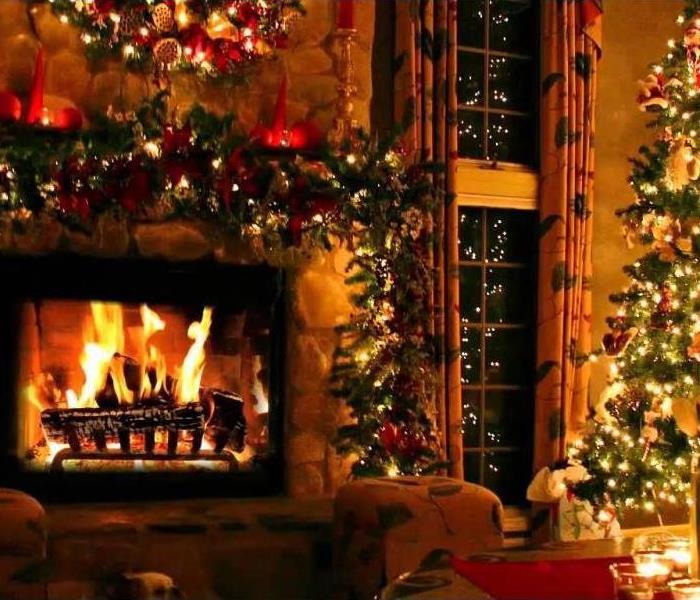 Home fires are a big threat to Americans. Knowing what causes them and how to prevent them can be all the difference.
Home fires are a big threat to Americans. Knowing what causes them and how to prevent them can be all the difference.
With holiday season just around the corner. Tips to ensure you all stay safe. We want the holidays to be full of cheer, fun, and wonderful memories.
Holiday home fires can put a damper on that. Here some facts on what to keep an eye out for.
Fast Facts
• Nearly 47,000 fires occur during the winter
holidays claiming more than 500 lives,
causing more than 2,200 injuries, and costing
$554 million in property damage.**
• On average, one of every 22 home fires
started by Christmas trees result in death.***
• Candle fires are four times as likely to occur
during the winter holidays.**
• During the winter holiday season, an average
of 40 home fires per day are caused by
children playing.**
• The number of home fires the American Red
Cross has responded to has risen 10% since
2000.*
• Having a working smoke alarm reduces one’s
chances of dying in a fire by nearly half.**
Preparedness Tips
Place Christmas trees, candles, and other holiday decorations at least three feet away from heat
sources like fireplaces, portable heaters, radiators, heat vents and candles.
Purchase flame retardant metallic or artificial trees. If you purchase a real tree, make sure that it
has fresh, green needles that aren’t easily broken. Keep live trees as moist as possible by giving
them plenty of water.
Make sure that light strings and other holiday decorations are in good condition. Do not use
anything with frayed electrical cords and always follow the manufacturer’s instructions.
Always unplug tree and holiday lights before leaving home or going to bed.
Never use lit candles to decorate a tree. Always extinguish candles before leaving the room or
going to bed.
Use only sturdy tree stands designed not to tip over. Keep curious pets and children away from
Christmas trees.
Keep anything that can catch on fire—pot holders, oven mitts, wooden utensils, paper or plastic
bags, food packaging, and towels or curtains—away from your stove top.
Designate one person to walk around your home to make sure that all candles and smoking
materials are properly extinguished after guests leave.
Smoke alarms save lives. Install a smoke alarm near your kitchen, on each level of your home,
near sleeping areas, and inside and outside bedrooms if you sleep with doors closed. Use the
test button to check it each month. Replace all batteries at least once a year.
Visit www.redcross.org/homefires for more information on how to keep your home fire safe during
the holidays.
Sources: American Red Cross,* U.S. Fire Administration,** and the National Fire Protection Association.***
Burn Awareness Week is February 5-11
1/31/2017 (Permalink)
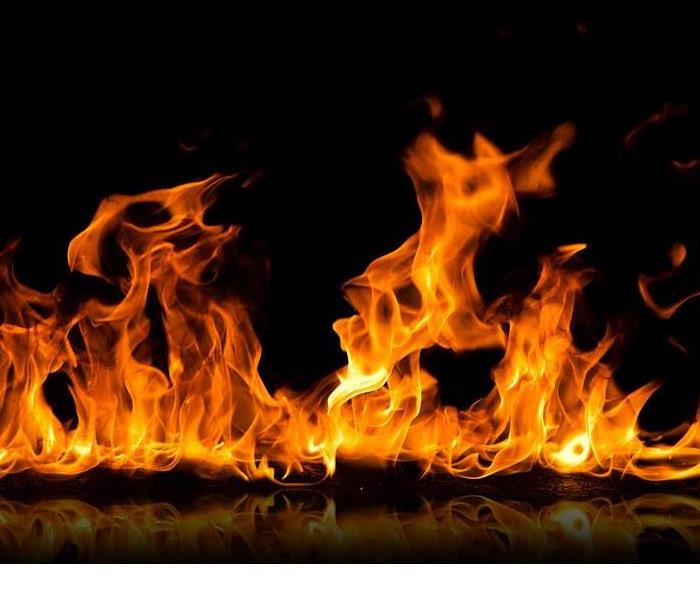 Fire, liquids, ands steam can all burn the same and the results can be devastating. Know how to stay safe.
Fire, liquids, ands steam can all burn the same and the results can be devastating. Know how to stay safe.
National Burn Awareness Week 2017
FACT SHEET
Burn injuries continue to be one of the leading causes of accidental death and injury in
the United States.
Between 2010 and 2014, approximately 486,000 people were seen in Emergency
Departments for treatment of non-fatal burn injuries.
In 2014 alone, there were 3,275 deaths from fires, which includes 2,795 deaths from
residential fires, 345 from vehicle crash fires, and 135 from other sources.
One civilian fire death occurs every 2 hours and 41 minutes.
The odds of a U.S. resident dying from exposure to fire, flames or smoke are 1 in 1442.
The primary causes of injury include fire-flame, scalds, electrical and chemicals.
Men are more likely to be burned than women (68% males and 32% females were seen
at a burn unit).
Most of the injuries occur in the home (73%) followed by work (8%).
Tragically, children, the elderly, and the disabled are especially vulnerable to burn injuries,
and almost one- third of all burn injuries occur in children under the age of 15.
Children under five are 2.4 times as likely as the general population to suffer burn injuries
that require emergency medical treatment.
Young adults ages 20-29 have a probability of burn injury that is roughly 1.5 times the risk
of the general population.
Today, 96.8% of those who suffer burn injuries will survive. Unfortunately, many of those
survivors will sustain serious scarring, life-long physical disabilities, and adjustment
difficulties.
Sources: 1. National Hospital Ambulatory Medical Care Survey: 2011 Emergency Department Summary Tables, Table 11 (accessed
at http://www.cdc.gov/nchs/data/ahcd/nhamcs_emergency/2011_ed_web_tables.pdf on June 2, 2016) and NEISS All Injury
Program operated by the Consumer Product Safety Commission for numbers of injuries. Bureau of Census for population estimates
(accessed at http://webappa.cdc.gov/sasweb/ncipc/nfirates2001.html on June 7, 2016). 2. National Fire Protection Association:
Fire Loss in the U.S. during 2014 (accessed on 2/8/16, at http://www.nfpa.org/research/reports-and-statistics/fires-in-theus/
overall-fire-problem/fire-loss-in-the-united-states). National Safety Council Injury Facts Sheet 2015 (accessed 2/8/16, at
http://www.nsc.org/learn/safety-knowledge/Pages/injury-facts-odds-of-dying.aspx). 3. National Inpatient Sample (HCUP-NIS:
2010 data); National Hospital Discharge Survey (2013 data); recent 100% hospitalization data from several states. 4. ABA National
Burn Repository 2015
Safely deep fry a turkey
11/16/2016 (Permalink)
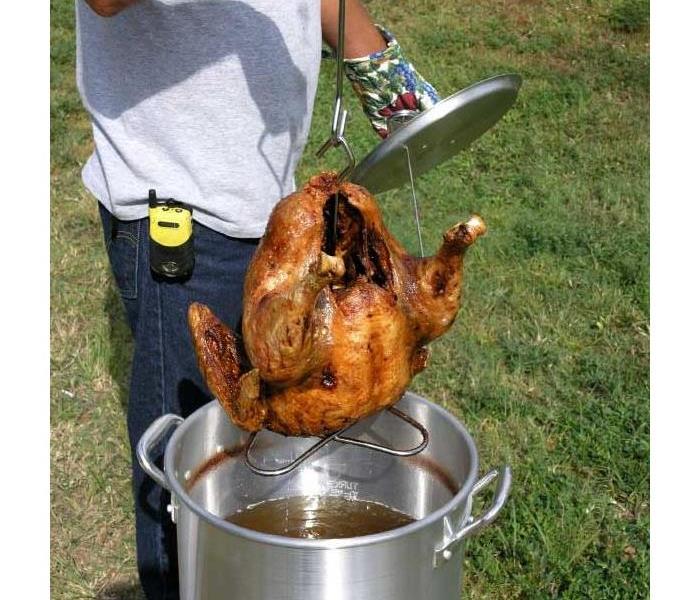 Properly deep frying a turkey can prevent dangerous fires.
Properly deep frying a turkey can prevent dangerous fires.
It is almost thanksgiving. Time for friend’s family and food. Many believe that turkey is the best thing to serve and while many have their own methods for preparing it deep frying it has really caught on in recent years. What else has caught on are the fires from doing it improperly. This is not the way to start the holiday season. So let us really take a look at the dos and don’ts of this time honored tradition.
Key things to know before you start even attempting to fry it. Oil is flammable. It requires a lot of oil to deep fry a turkey 3 gallons or more. Do not do it in your home or on the leaves you did not bother to rake. Also your porch which may be flat is not an appropriate place to place your fryer either.
- Use an official Fryer ( NOT A TRASH BARELL)
- Make sure that the surface is totally flat
- Be outside
- Keep kids and Pets and inebriated people away from the set up area.
- Thaw the turkey (DO NOT USE A FROZEN TURKEY) Better yet use a never been frozen one
- Oil and water do not mix Rule Number one
- Marinades must be dry rubs any wet marinade will add water to the turkey and cause a lot of issues when submerged
- Size matters 14lbs or less you can fry the whole thing larger than that you have to take the legs and wings off
- DO NOT STUFF YOUR TURKEY
- Do not just drop your turkey into the fryer ( have a basket which can be lowered slowly into the fryer)
- Remove the wrapper. .. ( yes it had to be said)
- Check how much oil you need before you start.
- Place turkey in container
- Fill with water until turkey is covered completely
- Remove turkey
- Mark with a line on the fryer or use a ruler to measure where the water level is
- This is your oil fill line
- MAKE SURE YOU DRAIN OUT THE WATER FULLY and dry your container before filling with oil ( YES THAT NEEDED TO BE SAID TOO)
- Heat oil to 375 degrees
- Cook until dark meat measures 175-180 and white meat measures 165-170
- Stay at least 10 ft away from everything
- Have a fire extinguisher on hand
- Fryer stays hot for HOURS.. stay safe and fully cool before attempting to empty or move
Why all the warning about water and thawing fully patting dry and fire extinguisher. Oil and water do not mix. Oil has a very different flash point than water so when water is introduced to hot oil the rapid cooling forces the oil to splatter this splatter hitting anything flammable will cause it to catch fire and cause serious damage.
Please know that frying a turkey is always a delicious way to cook it, but knowing how to do it safely is imperative.
Holidays and Fire damage
10/27/2016 (Permalink)
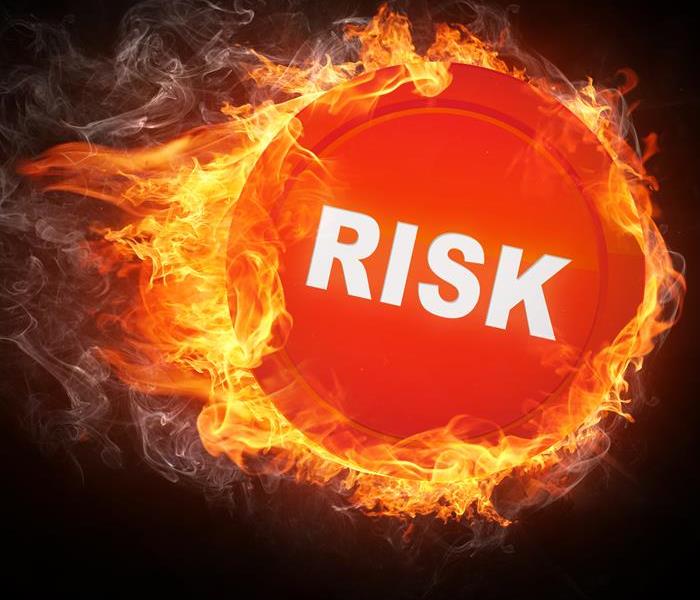 Fires increase during the holiday season. Know how to keep your family safe
Fires increase during the holiday season. Know how to keep your family safe
HOLIDAY HOME FIRES
Fast Facts
Nearly 47,000 fires occur during the winter holidays claiming more than 500 lives, causing more than 2,200 injuries, and costing $554 million in property damage.**
On average, one of every 22 home fires started by Christmas trees result in death.***
Candle fires are four times as likely to occur during the winter holidays.**
During the winter holiday season, an average of 40 home fires per day are caused by children playing.**
The number of home fires the American Red Cross has responded to has risen 10% since 2000.*
Having a working smoke alarm reduces one’s chances of dying in a fire by nearly half.**
Preparedness Tips
Place Christmas trees, candles, and other holiday decorations at least three feet away from heat sources like fireplaces, portable heaters, radiators, heat vents and candles.
Purchase flame retardant metallic or artificial trees. If you purchase a real tree, make sure that it
has fresh, green needles that aren’t easily broken. Keep live trees as moist as possible by giving them plenty of water.
Make sure that light strings and other holiday decorations are in good condition. Do not use anything with frayed electrical cords and always follow the manufacturer’s instructions.
Always unplug tree and holiday lights before leaving home or going to bed.
Never use lit candles to decorate a tree. Always extinguish candles before leaving the room or going to bed.
Use only sturdy tree stands designed not to tip over. Keep curious pets and children away from Christmas trees.
Keep anything that can catch on fire—pot holders, oven mitts, wooden utensils, paper or plastic bags, food packaging, and towels or curtains—away from your stove top.
Designate one person to walk around your home to make sure that all candles and smoking materials are properly extinguished after guests leave.
Smoke alarms save lives. Install a smoke alarm near your kitchen, on each level of your home,
near sleeping areas, and inside and outside bedrooms if you sleep with doors closed. Use the
test button to check it each month. Replace all batteries at least once a year.
Visit www.redcross.org/homefires for more information on how to keep your home fire safe during the holidays.
Sources: American Red Cross,* U.S. Fire Administration,** and the National Fire Protection Association.***
Fire Safety and why you should care !!!
10/11/2016 (Permalink)
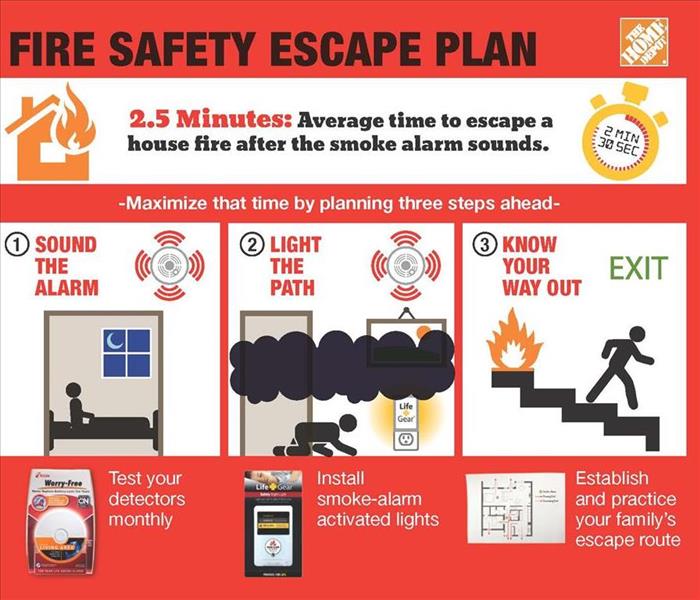 Having an escape plan for when a fire breaks out is important. Being prepared will make all the difference
Having an escape plan for when a fire breaks out is important. Being prepared will make all the difference
According to statistical data from the National Fire Protection Association (NFPA) in 2012 an estimated 1,375,500 fires were responded to in the United States. These blazes caused 2,855 deaths and 16,500 civilian injuries while costing more than $12.4 billion in damage.
Though some fires are unavoidable acts of nature or unpredictable accidents, many fires in the home and workplace are avoidable. The following tips, courtesy of the NFPA, can help reduce the likelihood of a fire in your business or home.
- Watch your cooking- Stay in the kitchen if you are frying, grilling or broiling food. Never allow young children around the stove or oven, especially if they are not closely attended.
- Give space heaters space- Keep space heaters at least three feet from anything that can burn
- Smoke outside- If you must smoke inside, have a sturdy, deep ashtray. Never smoke in bed
- Keep Matched and lighters out of reach- Keep matches and lighters in high cabinets, preferably under a child lock
- Inspect electrical cords- Replace cords that are cracked, damaged, have broken plugs or have loose connections.
- Be careful when using candles- Keep candles at least one foot from anything that can burn. Blow them out before you leave the room or go to sleep.
- Have a fire escape plan-Make a fire escape plan and practice it at least twice a year.
- Install smoke alarms- Install alarms on every level of your office or home and inside bedrooms. Interconnect them so they will all sound at once
- Test smoke alarms- Test alarms once per month. Replace batteries once per year as needed.
- Install sprinklers- Sprinklers can help maintain and sometimes even extinguish fires, giving your local fire department a better chance at saving your property.
Fire escape planning tips
Below you will find several tips that could potentially save your life or the life of a loved one should a fire break out in your home
- Install a smoke alarm on every level of your home
- Test smoke alarm batteries every month and change them at least ones a year.
- Consider installing a 10 year lithium battery powered smoke alarm
- Practice finding your way out of the house with your eyes closed, crawling or staying low and feeling your way out of the house.
- Remember escape first, then notify the fire department.
- **Tips courtesy of www.usfa.dhs.gov**
What to do until help arrives.
Do:
- Limit movement in the home to prevent soot particles from spreading and additional damage from occurring.
- Place clean towels or old linens in rugs and high traffic areas and upholstery
- Coat chrome faucets, trim and appliances with petroleum jelly or oil
- Place Aluminum foil or wood blocks between furniture legs and wet carpet.
Do Not:
- Wash any walls or painted surfaces.
- Shampoo carpet or upholstery
- Clean any electrical equipment.
- Send Clothing to dry cleaner since improper cleaning may set smoke odor.
Tips to help prevent a fire
10/4/2016 (Permalink)
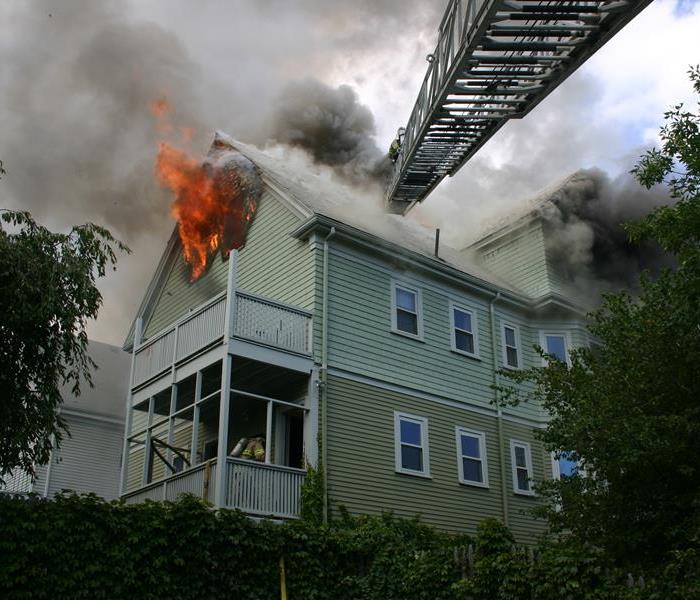 Fires in a home can quickly become out of control it is important to get out everyone out of the home rather than try and fight it yourself.
Fires in a home can quickly become out of control it is important to get out everyone out of the home rather than try and fight it yourself.
Getting out of the house is the most important thing to do when a fire breaks out. Time is not on your side. Having a plan, mapping escape routes, and doing practice scenarios can save your life. Make sure you call 911 as soon as possible, preferrably once you are outside. Have a central meeting point for your entire family a safe distance away from your home. Our partnership with the American Red Cross is to ensure you are prepared for anything, including fires.
Our friends at the National Fire Protection Association have some very interresting facts about fires we think you should know. You can always visit their website for this and other important information about fires at the following.
http://www.nfpa.org/public-education/campaigns/fire-prevention-week/fast-facts-about-fire
Home fires
- Half of home fire deaths result from fires reported between 11 p.m. and 7 a.m. when most people are asleep. Only one in five home fires were reported during these hours.
- One quarter of home fire deaths were caused by fires that started in the bedroom. Another quarter resulted from fires in the living room, family room or den.
- Three out of five home fire deaths happen from fires in homes with no smoke alarms or no working smoke alarms.
- In 2014, U.S. fire departments responded to an estimated 367,500 home structure fires. These fires caused 2,745 deaths, 11,825 civilian injuries, and $6.8 billion in direct damage.
- On average, seven people die in U.S. home fires per day.
- Cooking equipment is the leading cause of home fire injuries, followed by heating equipment.
- Smoking materials are the leading cause of home fire deaths.
- Most fatal fires kill one or two people. In 2014, 15 home fires killed five or more people resulting in a total of 88 deaths.
- During 2009-2013, roughly one of every 335 households had a reported home fire per year.
- Smoke alarms
- Three out of five home fire deaths in 2009-2013 were caused by fires in homes with no smoke alarms or no working smoke alarms.
- Working smoke alarms cut the risk of dying in reported home fires in half.
- In fires considered large enough to activate the smoke alarm, hardwired alarms operated 94% of the time, while battery powered alarms operated 80% of the time.
- When smoke alarms fail to operate, it is usually because batteries are missing, disconnected, or dead.
- An ionization smoke alarm is generally more responsive to flaming fires and a photoelectric smoke alarm is generally more responsive to smoldering fires. For the best protection, or where extra time is needed to awaken or assist others, both types of alarms, or combination ionization and photoelectric alarms are recommended.
- Escape planning
- According to an NFPA survey, only one-third of Americans have both developed and practiced a home fire escape plan.
- Almost three-quarters of Americans do have an escape plan; however, more than half never practiced it.
- One-third of survey respondents who made an estimate thought they would have at least 6 minutes before a fire in their home would become life threatening. The time available is often less. Only 8% said their first thought on hearing a smoke alarm would be to get out!
- Cooking
- U.S. fire departments responded to an estimated annual average of 162,400 cooking-related fires between 2009-2013 resulting in 430 civilian deaths, 5,400 civilian injuries and 1.1 billion in direct damage.
- Two of every five home fires started in the kitchen.
- Unattended cooking was a factor in one-third of reported home cooking fires.
- Two-thirds of home cooking fires started with ignition of food or other cooking materials.
- Ranges accounted for three of every five (61%) home cooking fire incidents. Ovens accounted for 13%.
- Children under five face a higher risk of non-fire burns associated with cooking and hot food and drinks than of being hurt in a cooking fire.
- Children under five accounted for 30% of the 4,300 microwave oven scald burns seen in hospital emergency rooms during 2014.
- Clothing was the item first ignited in less than 1% of home cooking fires, but these incidents accounted for 18% of the cooking fire deaths.
- More than half of people injured in home fires involving cooking equipment were hurt while attempting to fight the fire themselves.
- Frying is the leading activity associated with cooking fires.
- Heating
- The leading factor contributing to heating equipment fires was failure to clean. This usually involved creosote build-up in chimneys.
- Portable or fixed space heaters, including wood stoves, were involved in one-third (33%) of home heating fires and four out of five (81%) home heating deaths.
- Just over half of home heating fire deaths resulted from fires caused by heating equipment too close to things that can burn, such as upholstered furniture, clothing, mattresses or bedding.
- In most years, heating equipment is the second leading cause of home fires, fire deaths, and fire injuries.
- Once you are safe, the fire is out, and the emergency services are gone, what happens next? You have to focus on the clean up and getting back to normal. There is a lot more into cleaning up after a fire than you can imagine. Knowing who can work with fire restoration to get your home back to normal is so important. They must know how to get the smoke odor removed, what to remove that is not salvageable along with what can be saved.
- Here is to keeping you happy, healthy and safe as we approach the holiday season..
Fires and summer safety
7/27/2016 (Permalink)
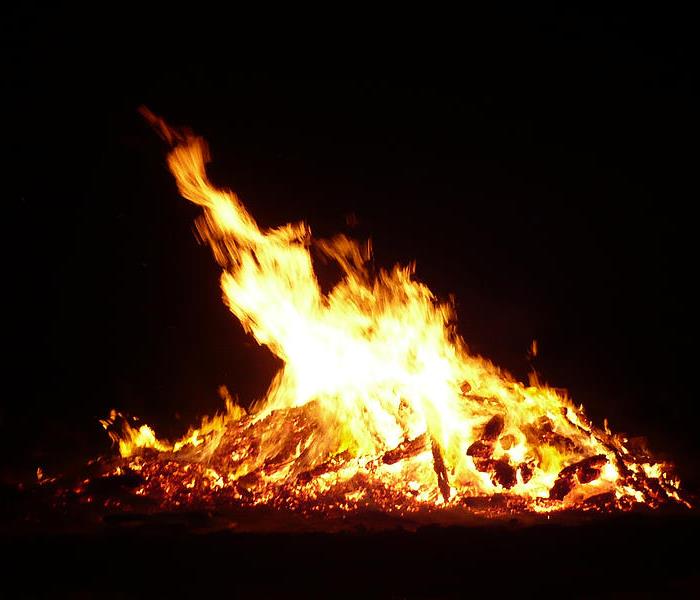 Summers are a great time to tell stories and gather around a campfire or have cook out but these actvities all involve fire.Staying safe is important
Summers are a great time to tell stories and gather around a campfire or have cook out but these actvities all involve fire.Staying safe is important
Fires and summer safety
Did you know that summer is one of the most dangerous times for fires. With all of the recent fires in the area we thought we would use this time to educate you on how you can stay safe this summer while still having a great time. For those of you who do not know we are on the border of a severe drought in MA.
A number of towns have already imposed mandatory water restrictions with many asking the public to adhere to voluntary ones. We have provided you with a link to check and see what your town is asking of you.
http://www.mass.gov/eea/agencies/massdep/water/watersheds/municipal-water-use-restrictions.html
Typically water restrictions limit the use of water outside the home, meaning no lawn and flower watering, car washing, power washing sidewalks or siding on homes just to name a few. That being said these restrictions are to ensure everyone has water for drinking and bathing please adhere to them and do you part.
But water restrictions also mean there is a lack of rain fall. This lack of water has severe implications and does increase the fire risk. It is important to know ways you can help not only conserve water but reduce the risk of fire. With everything being so dry it does not take much for fire to get out of control. Please see the tips below to keep your summer fun and safe for everyone.
Camping is fun
Smores over a campfire is a great childhood memory but fire safety is very important especially during a drought. Below you will find some key points to keep you safe. If you'll be spending the summer camping or just toasting marshmallows in the back yard, it's a good idea to educate yourself about campfire safety. Keep the following tips in mind.
Rules Rules RulesFollow Area Rules
Campsites always have posted rules based on the area, season and local conditions. Be aware of what they are and know there is a reason they exist. Some times these rules will have fire bans or strict burning regulations so always check the regulations before you start the fire.
You can catch fire too
Embers from fires can land on clothing, causing them to catch on fire. Knowing the old adage stop drop and roll is important. Role playing is an important way to make sure everyone in the family knows how to put this sort of fire out. Practice will prevent panic.
Where to set up the fire
The spot you choose to set up your fire is vital for your safety. Making sure there is no loose brush such as leaves, grass, or underbrush and if there is clear it away first. It is also advisable to steer clear of overhanging branches. It is best to dig a pit to set up the fire in and surround it with rocks. These rocks create a barrier for debris as well as shields the fire from wind helping contain embers. .
Flammable materials
Guess what fluids like gas, lighter fluid and charcoal is flammable. Keep these items a safe distance away from the open flames and fire pit itself as stray flames can ignite them. Please Please Please keep your tent away from the fire. Being zippered into something on fire is never a good thing. It is advisable to buy a tent with a flame retardant material.
Bonfires Keep It Under Control
Large bonfires are great and the roar of the flames the good times as we gather around them but can easily become uncontrollable. Make sure you are able to manage the size of the fire and have all the safety equipment to douse any flames. Smaller fires are much more manageable and can be just as fun knowing everyone is safe.
Do not leave fire unattended.
Rule of thumb never ever leave a fire unattended last to bed extinguishes the fire. Dousing the flames and embers with water is not enough you must stir them and douse them again. This should be done several times until you are sure that it is safe and no lose embers will blow away. Keeping plenty of water or a fire extinguisher is always a good idea anytime you will near a fire. A shovel is just as important allowing you to extinguish areas that may get out of the main fire area.
Fire Safety Tips for Summer Travel
Source
Summer is a great time to take a road trip or go camping, but it's smart to stay away of fire safety on your trip. Keep these tips in mind.
Where to stay
Vacation is here, fire safety is very important and should be on your mind. Ensure where ever you stay has the proper fire safety equipment, smoke detectors, and sprinkler systems. It is a good idea to know where the emergency exits are and review the posted escape plan. They should also have a safety check list provided to you it is a good idea to review this as well. If these are missing choosing another location is best for you and your family.Many of us while on vacation will visit new sites and locations . It is vital to know know where all exits are located. Taking a few moments can make the world of difference. Should a fire or other emergency situation break out knowing how to evacuate is vital.
Do your part NEVER Throw Lit Cigarettes out of the Car
Never throw a lit cigarette, match, or cigar out of a car window or onto the ground. It could ignite dry vegetation or even in rare circumstances, ignite fumes from your vehicle.
Fireworks Safety
Its that times of the year the bright colors and the gathering to look up at the sky at night through the roar of the fireworks. This is a very real safety concern in the summer especially during a state of drought. Please make sure you are careful to familiarize yourself with fireworks safety tips provided by the United States Fire Safety Administration
Grill safety tips.
Outdoor grilling is great we love it just as much as everyone else but you must stay safe no matter what sort of grilling you plan on doing. See our earlier blog posts on our website about grilling safety tips. So that you can have a safe delicious time.
Your home and wildfires
Many parts of the US and Canada ( yes that massive fire is still burning) have fallen victim to a wild fire this summer. Natural disasters do not always involve tornados or water. Our friends at Federal Emergency Management Agency (FEMA) have to ways to keep you safe and updated with emergencies. Fires move quickly and time is of the essence if you have to evacuate. Preparedness is our mantra and these situations are no difference..
Making a plan
Map out an escape route from the home and a central meeting point along with a route you will take in your car along with a central meeting point should members of your home be away at the time of the evacuation. Make sure you have each access to the plan.
Emergency kit
Evacuation means you have to have at least 3 days worth of food and water. Ensure that the food is easy to open but will also last without refrigeration. Compile a supply of medicines and medical supplies such as band aids, ointments, and bandages. Store this in a convenient place that is easily accessible.
Created a buffer zone
Remove all yard loose debris such as leaves, sticks, twigs, vines, branches, any firewood, or other flammable materials. Keeping the grass short will ensure that the fuel for flames will be kept at a minimum. Move any oils, gas or combustible liquids as far away as you can get them. Extend this zone as far as you can FEMA recommends 30-100 ft
Mark you home clearly
Make sure your house number is visible from the street so if emergency services need to find the home it is easy for them to do so.
Enjoy the Summer
By knowing and practicing summer fire safety tips, you can enjoy many wonderful times in the great outdoors filled with laughter, happiness and safety.
Grilling Safety Tips
6/1/2016 (Permalink)
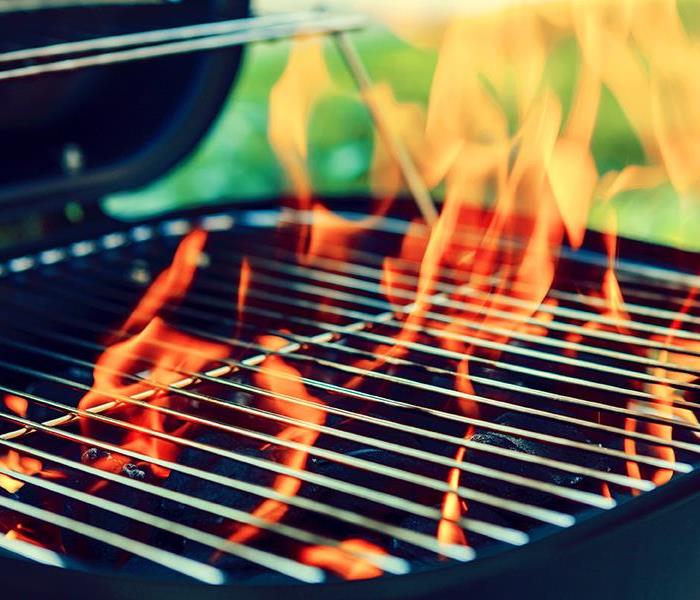 Grilling is a big part of summer ...preventing embers from catching fire, and smoke from damaging your home or your neighbors is very important
Grilling is a big part of summer ...preventing embers from catching fire, and smoke from damaging your home or your neighbors is very important
Grilling safety tips
Our Friends at National Fire Protection Association have put out this great article on Grilling safety and since most fires start with cooking we think it’s a pretty good idea to get some key tips now that Memorial day has come and gone.
http://www.google.com/url?sa=t&rct=j&q=&esrc=s&source=web&cd=2&ved=0ahUKEwiRssS8wsjNAhUFdj4KHazpCYUQFggiMAE&url=http%3A%2F%2Fwww.nfpa.org%2F~%2Fmedia%2Ffiles%2Fsafety-information%2Fsafety-tip-sheets%2Fgrilling_safety_tips.pdf%3Fla%3Den&usg=AFQjCNHLoEmZSOpc_BrwBk_NDvQ2lnL8PA&sig2=QJmDl8jj2w4k7O9MiPjnXg
Fire in the grill, under hot dogs and burgers, is a welcome sight at the family cookout. But fire anywhere else can make your summer kick-off barbecue memorable for all the wrong reasons. To keep you and your family safe while grilling, follow these general guidelines:
General grilling tips
Propane and charcoal BBQ grills should only be used outdoors.
The grill should be placed well away from the home, deck railings and out from under eaves and overhanging branches.
Keep children and pets away from the grill area.
Keep your grill clean by removing grease or fat buildup from the grills and in trays below the grill.
Never leave your grill unattended.
Propane grills
Video: Guy Colonna, NFPA Division Manager, Industrial & Chemical Engineering, gives some basic tips on how to prepare your grill before your first cookout of the season.
Before you use your grill:
Check the major connection points between the gas (propane) tank hose and the regulator and cylinder, and where the hose connects to the burners. Tighten if loose.
Check the gas (propane) tank hose for the potential (gas) leaks. To do that:
Apply a light soap and water solution to the hose using a brush or spray bottle.
Turn the propane tank on. If there is a gas leak, the propane will release bubbles around the hose (big enough to see).
If there are no bubbles, your grill is safe to use.
If there are bubbles, turn off the tank and check connections, then have your grill serviced by a professional before using it again.
If the leak doesn’t stop, call the fire department immediately.
When the grill is on:
As you are cooking, if you smell gas, turn off the gas tank and burners.
If the leak stops immediately, get the grill serviced by a professional before using it again.
If the smell continues, move away from the grill and call the fire department immediately. Do not move the grill.
Charcoal grills
There are several ways to get the charcoal ready to use. Charcoal chimney starters allow you to start the charcoal using newspaper as a fuel.
If you use a starter fluid, use only charcoal starter fluid. Never add charcoal fluid or any other flammable liquids to the fire.
Keep charcoal fluid out of the reach of children and away from heat sources.
There are also electric charcoal starters, which do not use fire. Be sure to use an extension cord for outdoor use.
When you are finished grilling, let the coals completely cool before disposing in a metal container.
Fire Damage is just as important to clean up
4/4/2016 (Permalink)
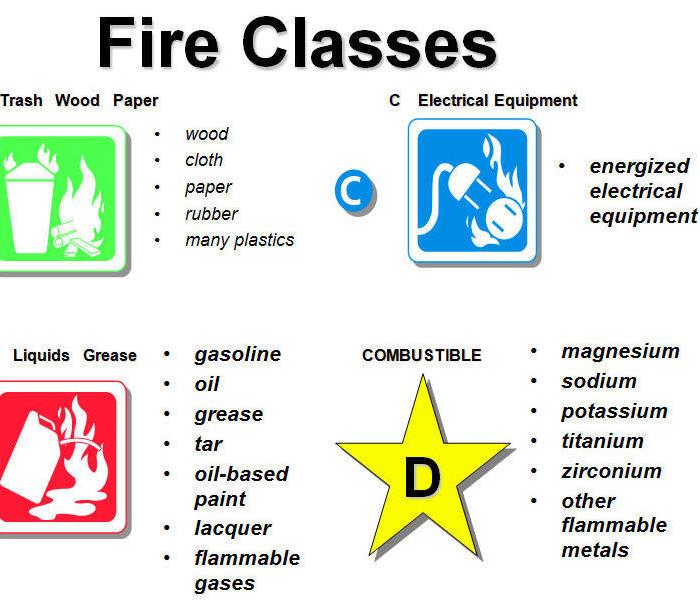 ABC's of Fire extinguishers... Getting the right one can be the difference between life and death... Know what you need
ABC's of Fire extinguishers... Getting the right one can be the difference between life and death... Know what you need
Fire Damage…..
Think water damage is the only thing that needs a quick response …Think again..
The number one cause of fires in the home are from cooking and 34% of them result from someone walking away from the stove.
Life is busy.. It is very easy to get distracted these days. Multi-tasking has become a habit and despite what we are taught it is not actually better.
Staying focused on the task at hand provides you with a more concise timely resolution with accurate results. No matter what sort of tasks you are doing and trying to accomplish. This is especially important when working in a kitchen.
No matter what you are using to cook… A microwave, toaster, hot plate, gas / electric stove, or even a crock pot which many of us set and forget can be dangerous. Walking away from something that is hot can have dire consequences.
Did you know that the numbers on your toaster are actually for minuets? So when you walk away from your toaster for the 2n time and your toast has burnt to a crisp and you had it on high you could have in theory had your bread in the toaster for upwards of 10 minutes. Dried out bread can catch fire very easily and cause an electrical fire in your home. Not being prepared can be very dangerous.
Fire can get out of control in as little as 30 seconds and more than 12K people are injured every year in a fire. A small home fire is nothing to mess around with. Having the right kind of fire extinguisher to put of various types of fires is very important. Just having a fire extinguisher is not enough , having the right one is pivotal..
For example electrical and grease fires cannot be put out in the same manner as a fire that starts from say a wood stove or fire place. Did you know that actually throwing water on a grease fire will make matters worse and cause the fire to expand more rapidly?
We use the term disaster to be all encompassing and maybe even a little too broad within our industry. Fire damage specifically kitchen fires can be broken down into some simple terms. Stove fires.. Toaster fires….Grease fires.. Vent and exhaust fires and even fires from your microwave.
Below you will find some statistics on home cooking fires.
42% of surveyed consumers say they have left the kitchen to talk or text on the phone, and 35 % have left to use the computer to check email while food is cooking. If you tend to do a lot of cooking, invest in a second or third timer. They're an inexpensive way to stay safe while ensuring that your food does not overcook.
Nearly half (45 %) of consumers say they have left the room to watch television or listen to music. Multi-tasking during the busy day is tempting. If you succumb, it's important not to leave the stove or oven unattended
Nearly one third (29 percent) of consumers reported that they have intentionally disabled smoke alarms while cooking. (YIKES!!!!)
More than half (56 percent) of surveyed consumers said they plan to cook for family or friends this year - with 42 percent of those cooking for groups of 11 or more.
Fire damage can be extensive and wide spread even to areas of the home that the flames did not reach. The small particles that burned travel in the air throughout the home and due to their small size and nature can stick to just about anything.
Taking care of smoke, fire and soot damage is necessary and here is why. There are various types of soot damage and some are acidic which can stain a variety of surfaces if not treated quickly . Within hours all surfaces that have come in contact with fire and smoke damage begin to feel its affects. Wood furniture, floors and molding will need to be refinished, Metal will begin to rust and corrode. Clothing can become permanently stained and need to be thrown away. Walls will begin to absorb the particles and start to turn yellow.
Within weeks if left untreated soot exposure embeds into fibers and deep into porous materials continuing to deteriorate the items or property if not properly restored in a timely manner.
Any clothing bedding , curtains and washable materials should too be professionally cleaned because an alkaline cleaner neutralizes the acid from the soot. Make sure it is someone that has experience specifically with smoke damage.
Professional Restoration companies have the proper tools and training to get you back to normal without these lingering effects. From special sponges for removing soot and ash from the walls, air purifiers to scrub out the particles that have not settled on the anything yet, right down to high efficiency vacuums that have a great filtration system that prevents the soot from being redistributed into the air, they are even able to clean the vents above your stove that collect the grease which can be helpful to prevent fires in the first plac. We strongly recommend a professional whenever there is fire soot and smoke damage because improper cleaning will continue to damage the property and increase the costs down the road.
HOVER BOARDS??? FUN or HAZARD.. BE SAFE
2/10/2016 (Permalink)
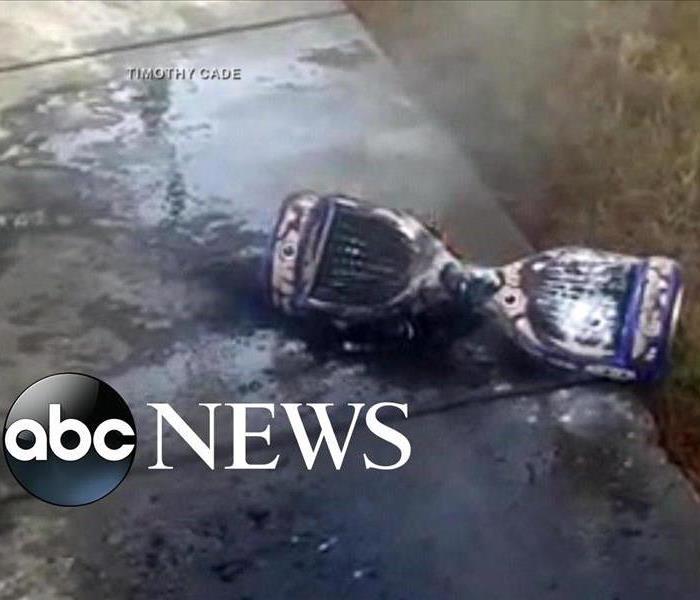 Hover Board injury/ fire danger
Hover Board injury/ fire danger
Hover boards
We are not really sure why these powered skateboards are being called hover boards but they are causing some serious problems and we want to make sure you are keeping your kids and your home safe.
Let us first examine the hover board itself. It is a battery powered scooter without handle bars. There are a variety of names for it but the design is simple. There are two wheels that have a small platform for your feet between them. The rider stands on the platform and a sensor on it then read your bodies movement and propels the board in the direction of travel desired or so it is supposed to do.
Emergency care facilities and emergency hospitals have seen an influx of visitors due to these new devices. This surge is in excess of 25% since Christmas along. They have seen such an increase that they have dubbed it the “Hover board Epidemic.” Think it is just the kids getting hurt on these devices nope they have seen patients’ age range from 10 to 50+. These injuries are just as varied from sprains to major fractures. Losing your balance, not taking the time to learn how properly mount and dismount the device and over confidence are all reasons for the increase in injuries. This device should be something that you learn carefully, in a safe setting not out on the street where a fall could lead to a car running you over or worse.
Injury is not the only danger lurking with these new devises. Fire, is a very real concern and below you will find what we were able to discover. Investigations are still ongoing and results could change through the continued research. We have seen far too many homes and images in the news about these little devices being the cause for some major fires. Please be safe and know the dangers and the steps you can take to prevent them.
Warnings have been issued and safety protocols have been set forth to aid in the prevention of a fire. It is recommended that the hover boards be purchased from a reputable dealer and not an off brand knock off. Also make sure the batteries and chargers are certified by a national testing lab such as Underwriters Laboratories. It is not clear the reason as to why they are catching fire, but it is clear they can easily overheat and burst into flames.
The charger could be partly to blame so make sure you are not charging them over night or when you are not home to monitor the situation and do not leave it on the charger and over charge. The boards are not only catching fire when they are being charged but when in use so please use caution and if it feels warm on your feet discontinue use immediately and bring it someplace safe to cool off.
If you wanted to bring it to your cousins’ house make sure you don’t have to fly many airlines have banned the shipment of the device due to the batteries claiming they are the main problem.
The batteries are lithium-ion batteries. What are they? And what makes them so dangerous? Lithium-Ion Batteries are an energy storage device which is generally safe unless shortcuts are made by less reputable firms. Which is why it is so important to be aware of where you product is coming from. Main failures are either normal failure rates tied to a very specific design flaws that can be recalled and corrected, but more concerning are those failures that do not point to a particular design flaw and are seemingly unexplained. Many of the failures of these batteries are said to be based on the cutting of corners from the design and build to improve profit margins on the products they are used in. Please be diligent and do not buy simply because it was the cheaper version. It could be deadly
SO what do you do? When these lithium-Ion batteries fail you will hear a hisses, see bulges. If safe to do so move the item away from anything combustible and place it on a non-combustible surface such as a sink or bathtub while you can use water we recommend a dry chemical see below Should you have time take the item outside get it outside and place on a paved area to burn itself out. Now while that is not always feasible there are ways to douse the devise to quell any flames. Fire extinguishers are best but it must be a Class D or and ABC Dry chemical extinguisher as water will make the fire worse. Dry powder will also work baking soda should be your first go to and most people will have this in their home but a copper powder, or a powdered graphite will also do the trick. We cannot emphasize enough we recommend a fire extinguisher on this type of fire.. While water is ok for the lithium-ion battery just not lithium metal it is a good idea to use the proper fire extinguisher. If you don’t already have one in your home it is a good idea to get one even if you don’t have a hover board.
We hope this helps keep you safe and happy surfing…
So the Fire is out... Now What????
2/2/2016 (Permalink)
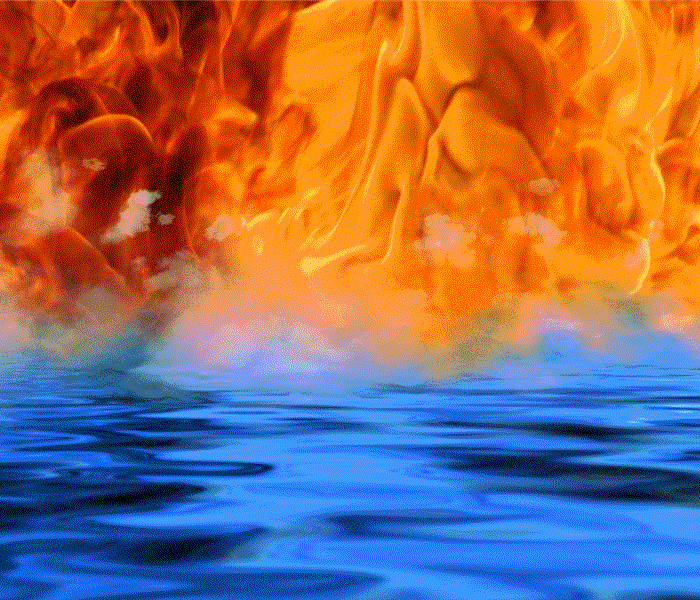 Fire Damage, How to ensure it is not there for ever
Fire Damage, How to ensure it is not there for ever
A back draft of emotions often sweeps over the homeowners after a fire ravages a home. Fear, uncertainty, stress and doubt about the future of the property can overwhelm the homeowner long after the flames have been extinguished and the smoke has cleared. So after the first wave of heroes have rescued the property, let your local SERVPRO professional help you restore it.
With the industry approved training to employ rapid response, the utmost professionalism, cutting-edge technology and open communication, we strive to restore not only the home, but your peace of mind, as well. So, before you risk doing further damage by attempting to clean up the damage yourself, call the fire damage cleanup and restoration professionals. Below you will find a list of services offered.
Restoration:
• Fire, Smoke and Soot
• Water Removal and Dehumidification
• Mold Mitigation and Remediation
• Catastrophic Storm Response
• Move Outs and Contents Restoration
• Electronics and Equipment
• Document Drying
• Contents Claim Inventory Service
Cleaning:
• Air Ducts and HVAC
• Biohazard, Crime Scene and Vandalism
• Carpet, Upholstery, Drapes and Blinds
• Ceilings, Walls and Hard Floors
• Deodorization
What You Can Do Until Help Arrives
The first 48 hours after a fire damage can make the difference between restoring versus replacing your property and personal belongings. Professionals can help prevent fire damage from creating long-term problems. They can also provide timely response with mitigation services ranging from fire, smoke and soot removal to contents claims inventory and document restoration. Quick action can help prevent fire damage from creating long-term problems these services help ensure your property, belongings and memories are restored to pre-loss condition when possible. Contacting a professional will help you regain control quickly. Despite the overwhelming desire to clean up as much as you can follow these steps to ensure that you have be end result.
1.Limit movement in the home to prevent soot particles from spreading and additional damage from occurring.
2.Place clean towels or old linens on rugs and highraffic areas and upholstery.
3.Coat chrome faucets, trim and appliances with petroleum jelly or oil.
4.Place aluminum foil or wood blocks between furniture legs and wet carpet.
****DO NOT DO ANY OF THE FOLLOWING****
Do not wash any walls or painted surfaces.
Do not shampoo carpet or upholstery.
Do not clean any electrical equipment.
Do not send clothing to a dry cleaner since improper cleaning may set smoke odor.
We hope that this helps you get back to “Like it never even happened”
You had a fire now what?????
1/7/2016 (Permalink)
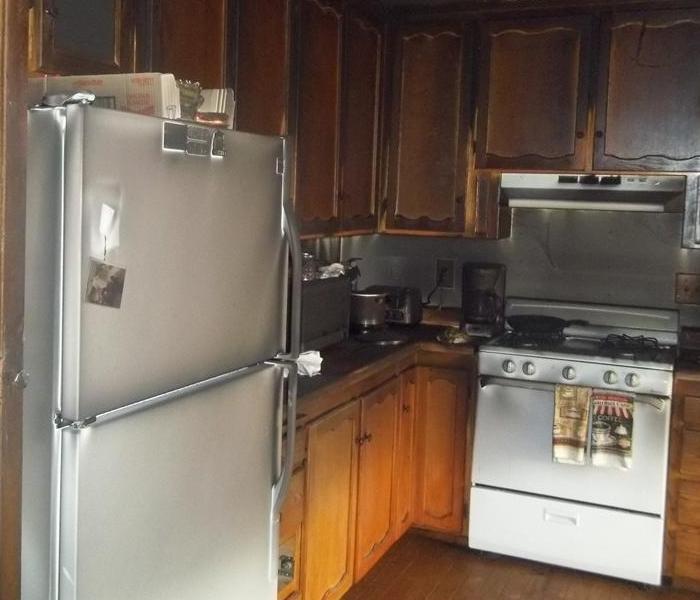 Smoke damage is so much more than you can see.
Smoke damage is so much more than you can see.
ACT QUICKLY and here's why.....
Smoke and Ash is everywhere. …Smoke is the fuel from the fire that did not burn it contains small particles of carbon and other materials. Fire gives off light, heat, carbon dioxide and water vapors. Smoke has all of this in it in microscopic form. It also contains soot ash and residuals from anything that was actually burning during the fire. Various types of smoke can contain chemicals that are dangerous to your health. While every fire will not contain it all, it is good to have an understanding of the importance of getting rid of the smoke. EPA studies show that methane, formaldehyde, Acetic acid, formic acid, toluenes, oxides of nitrogen, sulfur dioxide, organic carbon, and traces of heavy metals have all been found in smoke after fires. Ash will discolor most surfaces throughout your home or business and many surfaces and start to discolor immediately. If left for too long these discolorations may be permanent. Due to the acid nature of ash the longer it is there the more damaged it will cause.
Because wood is not the only thing that burns in a fire. Plastics, fabrics, foods, and other materials used in construction these too can produce toxic gases and other odors. While visible smoke may dissipate once the fire has been stopped. It does not mean that there is still not a great deal of damage to deal with. There are two kinds of smoke what they call driven and free floating. Fire also has two classifications high or low oxygen content and they will produce different kinds of damage.
When a fire is put out it changes from a dry heat to a hot humid heat. Depending on the method used to extinguish the fire the soot could be wet or dry and have a chemical residue left by extinguishers. This changes the relative humidity of the home or business depending on how much is needed to suppress the fire. Wood will expand and absorb the odors from the fire making it difficult to remove on your own.
Quickly removing soot and smoke damage is easier as some types of soot become more and more difficult to remove over time. Keep in mind even though items do not look damaged they could have suffered damage. Items could have melted slightly under the heat, things could be internally water logged, or the smoke film could be so thin you do not notice it and it has gotten inside the cracks of the items.
Contacting help as soon as possible also helps reduce the cost of the loss as many items may be salvaged if addressed right away. A professional will assess the situation and ensure that each and every item that needs to be restored is processed and what cannot be salvaged is removed so that the ash will not continue to coat surfaces. Using specialized odor neutralizing materials will be used and items should also be sealed off from the rest of the home to reduce permeating into the air until they have been restored.
Immediately calling your insurance carrier and notifying them of the damage is very important. Make sure you are asking for an adjuster to explain your situation and get the recovery process started as soon as possible. It is important to keep you and your family safe and ensure there are no toxic chemicals or hazardous materials in your home. Have a safety check conducted before you go back inside.
Contacting someone to help immediately will reduce the cost of the loss as many items may be salvaged if addressed right away. A professional will assess the situation and ensure that each and every item that needs to be restored is processed and what cannot be salvaged is removed so that the ash will not continue to coat surfaces. Using specialized odor neutralizing materials will be used and items should also be sealed off from the rest of the home to reduce permeating into the air until they have been restored.
Getting the right materials to remove the smoke from the various surface types throughout your home is exceedingly important. Knowing the proper drying times, humidity levels and pieces of equipment and chemicals needed to the job done properly will assist in getting you back to normal as quickly as possible. This is not always as easy as it seems which is why hiring a professional is strongly recommended. They have the formal training and products at their fingertips.





 24/7 Emergency Service
24/7 Emergency Service

























